#JAPAN: The Paradox of Harmony
Text
JAPAN: The Paradox of Harmony by Keiko Hirata and Mark Warschauer

4⭐️/5
Japan is known as one of the good countries with always about good things that we heard online or from advertisements. But, face it. No country is perfect, including Japan. This is something that is common in every country. This book is open for discussion of certain issues in Japan, which are The Whistleblower, Grass Eating Girly Men, Graying and Shrinking, Getting Along with the Neighbour, Meltdown, and finally, What We Learned at Lunch. All topics included real example and real conversations, I believe. The discussion was long for every chapter, which is why I limited my review to the interesting fact that I learn.
The first issue that was discussed was The Whistleblower. It includes the working condition of Japan, which for me was a flaw in others. Unlike Malaysian (who I believe like to jump jobs for better conditions and salary), Japanese will stay in the same company for a very long time (possibly for a lifetime). I have nothing to against, as long as I was treated with fair and good composition. Can you imagine how loyal the Japanese are to their employer? Even though the employer treats them badly, to the point they have to go to court just to claim their right. Yes, this is what happened in Japan. However, I don’t think Japan’s court was fair to the victims. The whistleblowers quickly become outcasts. And we are not yet talking about mandatory overtime and the guilty pressure if the employees take leave. ‘No Overtime Days’ was a scam. Yep, not a good sign. This is why there were lots of karoshi cases in Japan. Japanese also have a family system in that only men go to work while women take care of their families. For me, if I want a family, I need both to corporate. And I also can conclude that Japan’s workplace discrimination against women. There were lots of carriers for women to take up their careers, which is not fair. Just be clear, men will not be born if there are no women. So, be nice to women as well.
The second issue was about Grass Eating Girly Men, and yes, it is about men. An idea about men were men should find a company and work with them for the rest of their life, supporting their families while women stay at home. A little bit of lame and old thinking, but that was the ideal. However, some people have another idea about men in Japan. And there was a section dedicated to The Johnny’s, which I know a lots of people know them. And I am very happy that the author mentions Kitagawa’s serious allegation. I mean, come on. People talked when it happened. And the famous topic, Otaku men. Otaku is an insult in Japan, but in western and other Asia, we take it as pride (not me, really). Otaku to them is a geek, but some are still with them because of securities. And the Idol otaku. yeah, I don’t really understand the hype. I listen to them but for me to spend so much on people who don’t look at you, nope. So, this is why many women decide to be single women.
The third issue was about Graying and Shrinking, which is kind of related to the second issue. Yes, we are talking about the old population, which is one of the problems faced by the Japanese. When people don’t have an interest in marriage, the birth population decreased which leads to an increase in the old man population. In Japan, it is very popular for the Japanese to use seniority level in every aspect, including in prison. The certain reason that led to this situation is the low fertility rate as the main reasons for that were delayed marriage and non-marriage. Another reason is also that being a mother is not easy in Japan (again, not fair for mothers in Japan!) which is why women tend to have fewer children. So, the solution was to attract more foreign workers. But, this also lead to the next issue in Japan, which is racism and criticised as ripe for abuse. And not surprising that many foreign workers died due to karoshi.
Next, we have an issue with Getting along with the Neighbours. At first, I thought it is about the neighbour next door to their house (I mean I thought Japanese usually have a good relationship with their neighbour), but actually, it is not. It is about the neighbours’ countries. This is due to the face of the war before. The famous case is about comfort women. Japan also concurred Tanah Melayu before, so I believed Malaysia also was a victim of this, like Korea. Korea's anger toward Japan for this matter is understandable, especially when Japan refused to acknowledge this matter. There is also mention about policy, politics and issues of zanichi mentioned here. But, face it. I suck at politics, and politic matter. Well, the problem with Korea was not only about the comfort women, but also because of disputed islands between Japan and Korea. The K-wave does not reduce the tension at all. And Japan also needs to face this dispute with China as well.
The second last issue was regarding Meltdown, which is focused on nuclear in Japan. Fukushima becomes Japan’s Chornobyl (Chornobyl is very scary) because of the earthquake in 2011. It is very scary to deal with the destroyed rectors. Only after 19 months after the earthquake and tsunami, TEPCO acknowledged its faults in accident preparation. Although TEPCO had been warned about warning regarding the effect of earthquakes that measuring more than 8.3 can create disable Fukushima, the nuclear plant was still built. Yoshida, the man who save lives from the disaster of the nuclear leak and become the unsung hero who tried to save many live and Fukushima, was also one of the men in TECPO’s leaders who ignored the warning. The effect of this disaster was many people not only lost their land and house but also lost their life after that by suicide. Fukushima became a ghost town.
Lastly, we have What We Learned at Lunch. The Japanese school system was very unique and different from other systems in other countries. Japan has collective systems and students spend more time at school (I do not envy that. Malaysian felt very happy at the end of the school period and really want to go home as soon as they can). Teachers also become important in students’ life. Sometimes, when I read manga or watch anime or drama about high school in Japan, I always thought should parents be more concerned about their kids’ problems and life instead of teachers? What is used by parents? But, they have a good system of MEXT, which I acknowledge. No wonder Japanese students are at other levels compared to other students. Also, the Japanese are famous for school spirit. Maybe that made why students spend more time in school. Malaysian have it, but we do it because we have to. Some parents or teachers do not really support students in that. Still, there is some flaw in the education system. The famous flaw was the bullied culture, which is also faced by employees in the company. They bully people (usually weak students) in a group (which is totally cowardly move. Grow up!). Do you know the worst part? Sometimes, even teachers are afraid of bullies. They were afraid that they lost control of their class (that is not how it is going, sensei). And yes, the exam and testing. It is troublesome. Maybe not bad as the Korean exam, but still exam is the one thing that I am not envy in Japan.
So, yes! Japan has many good things happened that we learn and heard from Japan. But every country had its own flaw, including mine and Japan. There is no such perfect country in this world, but still, we can take every bad and good thing as a lesson for our own learning process.
Disclaimer: All the opinion about this book is based on my personal view!
#book review#JAPAN: The Paradox of Harmony#Keiko Hirata#Mark Warschauer#4.5/5#Cultural#Nonfiction#Sociology#miliyaread
1 note
·
View note
Text
2023 Recap - Songs from (QL) Dramas
I've been tagged by @troubled-mind to make a list of my favorites songs from this year's QL dramas (thank you so much 💕) and of course I can't resist. I liked a lot of music from shows this year, which is great but made the selection harder so it will be a little long, I hope you'll forgive me.
OST I've been milking in full
I don't very often go through full OST unless someone does a background music playlist i can put on (Like this one for La Pluie by troubled-mind, and this one for To Sir, With Love for example) but two stood out for me this year.
My School President OST - I knew in advance I would enjoy a musical show, and I have to say I was NOT disappointed. My favorite though is ฟัง by Fourth, Ford, Satang, Winny, and the fantastic Pijika Jittaputta. Have a go at the original too!
Unintentional Love Story OST - This one came late this year for me, but i have been listening to the whole thing again and again. My favorite is Beautiful Day by Cha Seowon. I really enjoy his voice a LOT, and I'm weak for a nice, so soft it's even a little mushy love ballad.
With those two out of the way, let's go through the list country by country I think.
From Thailand 🇹🇭
ลางสังหรณ์ by Teng Tachaya from The Sign
This one is just a banger! It literally rocks, and I keep belting out the chorus every single time i listen to it. I love everything about it, even the spoken words. Also, not music related, but that costume!!
เงา by Lazyloxy from Shadow
I like Lazyloxy's voice a lot, as well as the rhythm/bass line (?) during the verses. There is an edge in that song that fits the show very well, too.
พรุ่งนี้ by Ford Arun from Moonlight Chicken
Ford's voice, do I need to say more? Tbh I got a little teary the first (ten) time(s) I listen to it.This ballad is so very touching, it's gentle and hopeful, I can never tire of it.
Honorable mentions >
รักคุณยิ่งกว่าใคร by NuNew's cover of Got Jakraphan from Cutie Pie 2. I loved this one so much I got myself a video editor so I could post it there. Only honorable because it's a cover, but it got me into luk thung so it deserves to be here.
เพลง รักนี้มากับดวง by Bmine & Near from Lucky My Love. This one is just because it's goddamn cute, sweet and peppy, and it makes me smile and bop my head. Sometimes I don't ask for more.
From Japan 🇯🇵
U&I by Hi-Fi Unicorn from Kimi ni wa todokanai
It's just a perfectly crafted pop song imo. It's cute, fresh and lively, fitting the show perfectly too. Since it came out, you can catch me humming "kimi ni waaa todokanai hmm hmm hmm" all day, every day, so it deserves its place on the list!
Yoruwazura by osage feat Ishino Riko from Kimi to nara koi wo shite mite mo
This one got me the second Ishino Riko started singing. The harmonies between the two are SO good! I really like the guitar in this one, and the little claps in the background. It's also really easy to hum so it stays with me a lot.
Bitter by Royce from Utsukushii Kare season 2
The contrast between the energy of the melody and the nearly bored sound of the voice (the singer sounds like their mouth does not open fully) works reaaally well for me. It's catchy and fun, and well, the lyrics are just so perfectly Hira...
ふたたび Futatabi by HIROBA & Otsuka Ai from Bokura no micro na shuumatsu
I was very surprised when I saw it was a feat with Otsuka Ai (who I only knew for her sugary pop in early 2000). The melancholy of the lyrics and the melody are beautiful, I am a huge fan of the way their voices mesh together, and I can't resist a piano + violins combo like that.
Honorable mention > Go Sign by Billy Laurent from Ameiro Paradox. The little piano, the rhythm, that chorus, it makes me shake my ass every single time.
From Taiwan 🇹🇼
'痛苦擁抱 (Painful Hug) by Ozone from Oh No! Here Comes Trouble
(I won't hear anything about technicality and it being a QL show or not =3) Had not realized it was from a boy group before checking the clip for this list. I like the way the melody rises for the chorus, their voices are pleasant, and it carries both power and some sort of melancholy that reminds me very much of Pu Yiyong.
Honorable mention > Come With Me by K6 from Marry My Dead Body. The whole OST of that movie is great, but I somehow got completely obsessed by this one from the gym scene at the start. It also features Austin Lin (I think as backup on the chorus).
From Korea 🇰🇷
IoU by UTOPI from The New Employee
It's a sweet, simple one that never fails to put me in a good mood, and sometimes that's enough to listen to a song non stop over months =3
Natural by Young K from A Breeze of Love
This one is also sunny, light and joyful. I like the guitars and I am especially fond of Young K's voice - it got me looking into him which I do not regret. A nice little surprise for the end of the year.
Thank you if you made it all the way through it, otherwise...
Tl;dr you can find all songs under this playlist (´꒳`)♡
i'm not sure who would have fun doing this, maybe @iguessitsjustme if you fancy it? Anyone who see this and want to do it, please tag me so I can have a look at your faves! <3
#f i n a l l y managed to go through this one!#after rearranging it three times#but yes here are this year's favorites <3#music#(Kat you're stronger than me I would never have managed to keep it to 10 lol)
17 notes
·
View notes
Text
Great moogly googly I make progress at a snail’s pace. However, I know what Personas to give P5 AU Naoto now. To keep up with her dog motif and to be incredibly on the nose, her Personas are canines.
TLDR: Initial - Laelaps, Ultimate - Fenrir
Her initial Persona is Laelaps, a dog that never failed to catch what it hunted. Another thing about Laelaps’ mythology is about the Teumessian fox, which could never be caught. When a dog that always catches what it hunts chases after a fox that can never be caught, it results in a paradox. If hunting = detective skills for this comparison, then Naoto is like Laelaps.
Who the Teumessian foxes are vary depending on the context. The major one, the whole reason Naoto finally thinks about the PT is because of the similarities to the mental shutdowns, which were planned by the conspiracy. Since they had their hand in almost everything, police force included, Naoto would be chasing after something she could never catch.
Second is the police themselves. Dealing with the other things canon Naoto hated the police for—looking down on her for age and gender (hits harder here since she doesn’t disguise herself)—she chases after acceptance she will never obtain, and it doesn’t help that they do not follow what ‘justice’ is.
Figuring that out is the third thing she’s chasing. She’s grown accustomed to the corruption in the police force, although she abhors it greatly, but she is only one person and an outsider (private investigator with a contract to work with them), any attempts to speak about it will be ignored. Besides the police corruption aspect, in Japan, respecting your elders is key, and Japan has a collectivist (favors group harmony over the individual, essentially) society. Naoto is very careful about her rep, so she doesn’t want to say anything that could tarnish her name, and criticizing her seniors may lead to some major consequences.
Fourth would be the never-ending cycle of chasing down criminals. More on the metaphorical side, but while Naoto may catch one criminal, there’s always going to be someone else.
Laelaps’ appearance takes on the appearance of a hellhound, as a reference to the dog in The Hound of the Baskervilles. To be more specific, that one is based on the black dog that comes from English folklore, but hellhounds are a general mythological concept. It has glowing red eyes, a little oversized and accompanied by blue (because that’s Naoto’s color) flames. I’m toying around with the idea of the flames changing color depending on what elemental attack she uses, so that’s... fun. idk
Another thing about the black dog is that it’s generally seen as a sinister creature, however there are some stories about black dogs acting as guardians, so another point to the duality thing I swear I see with Naoto most prominently.
Moving on to Fenrir.
He’s a wolf, the son of Loki and he is chained to a rock until Ragnarök, where he’ll break free and kill Odin, to which one of Odin’s sons will kill him. It doesn’t sound like a Persona for Naoto, at least until you see the part where he breaks free from chains.
Break free from your chains, embrace rebellion, Naoto breaks from the paradox where Laelaps chasing after a fox that would never be caught, for the conspiracy related matters and her own life in general. More importantly, Fenrir appeared under the Fortune arcana in P2 (yes I’m being dead serious about this) and he’s a canine and there we go.
Now at the end, if you said this whole motif of Naoto and dogs came from that one uquiz where it asked what your underlying motif was and it said Naoto’s was a dog influenced me, you are half right, but only if you’ve been there to see that certified fact. And how could I not give her canine Personae when her official codename I made up myself is Hound.
#Headcanon: Confidential Information#v: Take Over#I did my part to make myself marketable#you can't say I didn't try
5 notes
·
View notes
Text
The upward contemplation of the splendid life in Chinoiserie
In 1735, a little-known “peintre en toiles” (painter on canvas) named Jean-Antoine Fraisse (1680?–1738/39) published a collection of decorative designs titled “The Book of Chinese Patterns.” This work was inspired by original pieces from Persia, India, China, and Japan, and was dedicated to his patron in Chantilly, Louis-Henri, the Prince of Condé (1692–1740).
After the deaths of Fraisse and the Prince of Condé, Gabriel Huquier (1695–1772) published several subsequent editions of Fraisse’s plates. Due to Huquier’s prominent position in the 18th-century French decorative arts scene, his reissues led to a reassessment of “The Book of Chinese Patterns,” greatly enhancing its significance. The Metropolitan Museum of Art holds the most complete known copy of “The Book of Chinese Patterns” to date, which includes 55 etchings and 8 woodcuts. Huquier, particularly attuned to the tastes and trends of his time, reconfigured Fraisse’s etchings, elevating Jean-Antoine Fraisse from relative obscurity to a more prominent position in the discussion of 18th-century French decorative arts. “The Book of Chinese Patterns” is not merely a product of the Prince of Condé’s imagination; it also reflects the specific tastes of its era and provided a source for various artisanal shops.
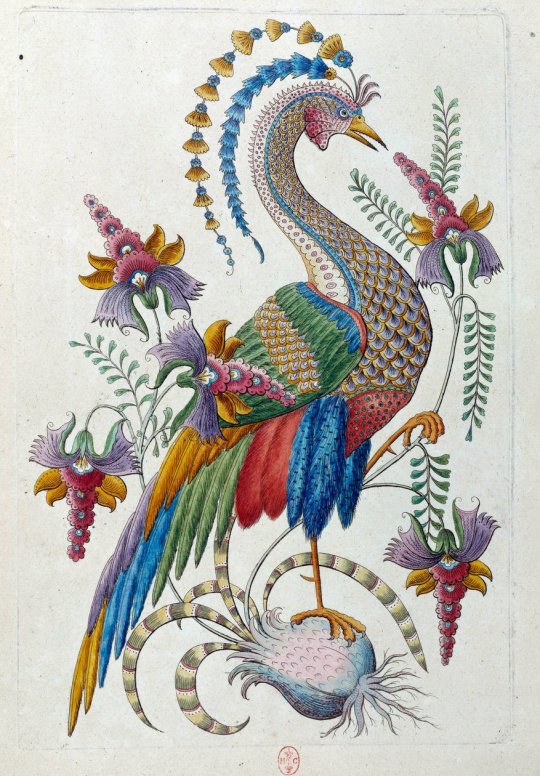
Jean-Antoine Fraisse’s “Fantastic Bird”
Many of Jean-Antoine Fraisse’s works draw inspiration from patterns found on Chinese porcelain. Compared to many European Chinoiserie artists, whose works were often based on imagination and reinterpretation, Fraisse’s works tend to align more closely with Eastern aesthetics, both in subject matter and technique. His piece “Fantastic Bird” almost entirely abandons the Italian-style shading and perspective, emphasizing a purely Eastern flat expression, highlighted by textures and intricate details rendered with precision. Jean-Antoine Fraisse employs the classic Eastern asymmetric composition, emulating the meticulous lines and fine brushwork, presenting the rich colors and light shading typical of detailed painting. The artwork, with its dreamlike and vivid quality, conveys auspicious symbolism through the mythical bird. The boundaries between the present and the past, the eternal and the fragile, dissolve into the intense and passionate colors, embodying an upward contemplation of a splendid life.
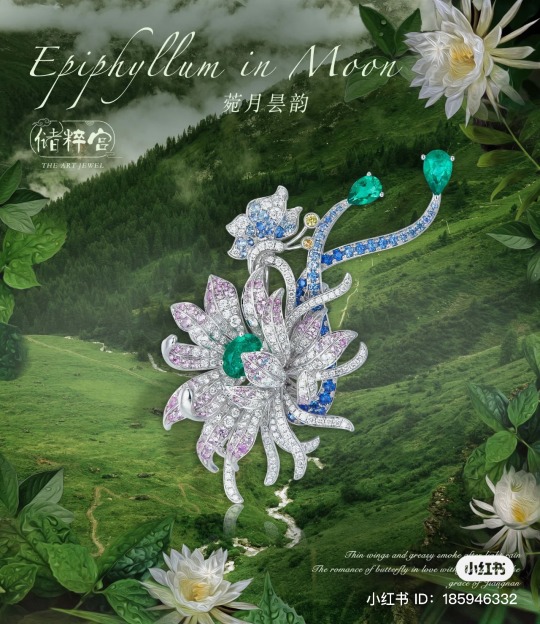
ChuCui Palace Epiphyllum in Moon Brooch
In addition to painting, the contemplation of life is also integrated into the works of Chinoiserie jewelry, represented by ChuCui Palace. Their piece “Epiphyllum in Moon” is rich in the dynamic curves characteristic of Chinoiserie, with fluttering flowers and leaves that flow gracefully. The varied lengths of the intertwined curves, whether ascending or descending, depict the intricate complexity of nature. The piece captures the fleeting bloom of the epiphyllum, which in Chinoiserie art symbolizes ephemeral beauty. In mythology, the epiphyllum often represents the eternal moment, a seeming paradox that signifies infinite meaning.
ChuCui Palace has innovatively combined the Chinese gongbi technique of layered color application with Western inlay methods, allowing colors to blend and diffuse like ink, creating a gentle and delicate poetic effect. The combination of flowers, leaves, and butterflies forms a harmonious interplay of points, lines, and surfaces. In composition, the work emphasizes both roundness and fullness, while intentionally incorporating asymmetrical lines reminiscent of wind and leaves, enhancing its graceful and natural aesthetic. The piece transcends temporal boundaries, surpassing mere craftsmanship, and captures an intuitive understanding of life. Though time passes and life is finite, the work resolves the paradox of the ephemeral and the eternal, providing a sense of life’s continuity in a softly flowing atmosphere.

The watercolor painting by Moses Griffith depicts the Chinese House at Shugborough Hall.
Another approach that is closer to nature and captures a more intuitive sense of life and aesthetic intuition is found in European Chinoiserie-style gardens. Chinese gardens first sparked particular interest in Britain, as they served as a template for breaking away from rigid European traditions. The aesthetic principles of Chinese gardens became the basis for analysis by 18th-century British literati, who regarded them as examples of “imitating nature” or “idealizing nature.” The layout of Chinese gardens, including waterfalls, artificial hills, canals and lakes, irregular slopes, railings, mysterious groves, and rocks, almost resembles miniature nature. Such designs were in contrast to the mainstream taste in European horticulture, which favored symmetry and regularity. Chinese gardens gradually presented different scenes — on mountains or by lakes, in forests or on wooden bridges, in courtyards or pagodas. Their sizes ranged from small areas in the backyard to landscapes reminiscent of the famous pastoral scenes in “Dream of the Red Chamber.” Chinese gardens embody the concept of wholeness, incorporating both the complexity of nature and the human experience of wandering, with spatial and temporal dimensions. Joseph Addison spoke highly of Chinese-style gardens, believing that the Chinese had “a natural Genius for hiding Art,” that “this kind of Beauty strikes the Imagination,” and that “there is a certain Majesty in Nature, which is more worth our Observation than all the fine Strokes and Features of Art.”
Simultaneously, the combination of gardening and architectural art, by constructing pagodas and Chinese-style buildings within the gardens, further reinforced the integration of diverse styles. This not only freed people from the strict rules and formal characteristics of classicism but also paved the way for the rise of Romanticism and individualism in 19th-century Britain.
In the exploration of life within 18th-century European art, Chinoiserie transcended mere praise of nature to become a profound reflection on the essence of life itself. Through Chinoiserie artworks, particularly in painting, sculpture, and decorative arts, people surpassed traditional European aesthetic concepts, delving into the diversity, complexity, and mystique of life. The Eastern aesthetic principles embodied in Chinoiserie, along with the imagination and pursuit of Eastern culture and nature, reflect humanity’s continual quest and exploration for the meaning of life. In Chinoiserie works, we can observe a deep respect and reverence for life, as well as profound reflections on nature, human emotions, and the spiritual realm. Therefore, Chinoiserie is not merely an artistic form but also a philosophical contemplation and expression of life, nature, and human existence.
0 notes
Photo
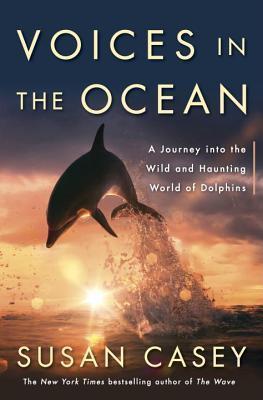

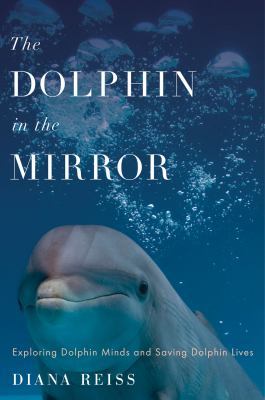
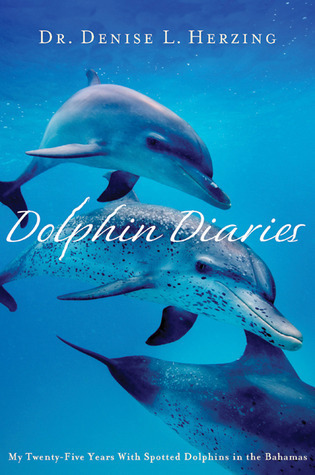
Book Recommendations: National Dolphin Day
Voices in the Ocean by Susan Casey
While swimming off the coast of Maui, Susan Casey was surrounded by a pod of spinner dolphins. It was a profoundly transporting experience, and it inspired her to embark on a two-year global adventure to explore the nature of these remarkable beings and their complex relationship to humanity. Casey examines the career of the controversial John Lilly, the pioneer of modern dolphin studies whose work eventually led him down some very strange paths. She visits a community in Hawaii whose adherents believe dolphins are the key to spiritual enlightenment, travels to Ireland, where a dolphin named as “the world’s most loyal animal” has delighted tourists and locals for decades with his friendly antics, and consults with the world’s leading marine researchers, whose sense of wonder inspired by the dolphins they study increases the more they discover.
Yet there is a dark side to our relationship with dolphins. They are the stars of a global multibillion-dollar captivity industry, whose money has fueled a sinister and lucrative trade in which dolphins are captured violently, then shipped and kept in brutal conditions. Casey’s investigation into this cruel underground takes her to the harrowing epicenter of the trade in the Solomon Islands, and to the Japanese town of Taiji, made famous by the Oscar-winning documentary The Cove, where she chronicles the annual slaughter and sale of dolphins in its narrow bay.
Casey ends her narrative on the island of Crete, where millennia-old frescoes and artwork document the great Minoan civilization, a culture which lived in harmony with dolphins, and whose example shows the way to a more enlightened coexistence with the natural world.
Dolphin Confidential by Maddalena Bearzi
Who hasn’t fantasized about the unique thrill of working among charismatic and clever dolphins in the wild? Now we no longer have to rely solely on our imaginations. With Dolphin Confidential, Maddalena Bearzi invites all of us shore-bound dreamers to join her and travel alongside the dolphins. In this fascinating account, she takes us inside the world of a marine scientist and offers a firsthand understanding of marine mammal behavior, as well as the frustrations, delights, and creativity that make up dolphin research.
In this intimate narrative, Bearzi recounts her experiences at sea, tracing her own evolution as a woman and a scientist from her earliest travails to her transformation into an advocate for conservation and dolphin protection. These compelling, in-depth descriptions of her fieldwork also present a captivating look into dolphin social behavior and intelligence. The central part of the book is devoted to the metropolitan bottlenose dolphins of California, as Bearzi draws on her extensive experience to offer insights into the daily lives of these creatures—as well as the difficulties involved in collecting the data that transforms hunches into hypotheses and eventually scientific facts. The book closes by addressing the critical environmental and conservation problems facing these magnificent, socially complex, highly intelligent, and emotional beings.
The Dolphin in the Mirror by Diana Reiss
For centuries, humans and dolphins have enjoyed a special relationship, evident not just in mythology and folklore but in many documented encounters. Some past cultures even worshipped dolphins and condemned anyone who killed or wounded of them. Yet in recent decades, a paradox: on the one hand, we have discovered extraordinary depths of dolphin intelligence and their emotional lives, to the point of glimpsing their self-consciousness—on the other hand, in Japan, dolphins are slaughtered indiscriminately, and several nations keep them in cruel conditions.
Diana Reiss is one of the world’s leading experts on dolphin intelligence who has helped lead the revolution in dolphin understanding for three decades. In addition, as an activist, she is a leading rescuer who helped inspire and served as an adviser for The Cove, and who continues to campaign against the annual Japanese slaughters. Here, she combines her science and activism to show us just how smart dolphins really are, and why we must stop mistreating them. Readers will be astonished at dolphins’ sonar capabilities; at their sophisticated, lifelong playfulness; at their emotional intelligence; and at their ability to bond with other species, including humans and even dogs! Her beloved companion dolphins, each with distinct personalities, create their own toys, type commands on a keyboard, tease and scold her playfully, and express their affection and delight. In Reiss’s most famous experiments, she used a mirror to prove that dolphins are self-aware, and even self-conscious. The Dolphin in the Mirror is both a scientific revelation and a emotional eye-opener, revealing one of the greatest intelligences on Earth.
Dolphin Diaries by Dr. Denise L. Herzing
Dr. Denise Herzing began her research with a pod of spotted dolphins in the 1980s. Now, almost three decades later, she has forged strong ties with many of these individuals, has witnessed and recorded them feeding, playing, fighting, mating, giving birth and communicating. Dolphin Diaries is an account of Herzing’s research and her surprising findings on wild dolphin behavior, interaction, and communication. Readers will be drawn into the highs and lows—the births and deaths, the discovery of unique and personalized behaviors, the threats dolphins face from environmental changes, and the many funny and wonderful encounters Denise painstakingly documented over many years. This is the perfect book for anyone who loves these incredibly versatile and intelligent creatures and wants to find out more than the dolphin show at the zoo can offer. Herzing is a true pioneer in her field and deserves a place in the pantheon of naturalists and scientists next to Dian Fossey and Jane Goodall.
#dolphins#marine biology#animals#marine life#nature#nonfiction#science#Nonfiction Reading#nonfiction books#non fiction#Library Books#reading recommendations#reading recs#Book Recommendations#book recs#TBR pile#tbr#tbrpile#to read#Want To Read#Booklr#book tumblr#book blog#library blog
1 note
·
View note
Text
Banana Fish boys and signature scent - some options
Hey, so I asked about the scents for the characters because I'm really into perfume and wanted to do a post like this based on your opinions of what the characters would smell like.
So, here's what I think:
Eiji: You said "the sweetest scent. he smells like marshmallow and orange blossom + his hair smells like lemons"
I couldn't quite find marshmallow and those citrus scents in a fragrance I thought would be fitting, but what I could come up with was:
Chanel Les Eaux de Chanel Paris-Deauville which is a fairly recent unisex release from Chanel in an eau de cologne style. It kinda of features all those citrus notes you mentioned (though it's certainly more orangey than lemoney) and has some nice sweetness from jasmine. It's also on a base of neutral, soothing woods that smells like a very typical type of fragrance that was very popular in Japan in the 90s, the kind of "Zen" fragrance (this is just the base, though, that gives it some heft and keeps it from being too sheer like most eaux de colognes; the fragrance as a whole is not woody and is much more a sweet-citrus-aromatic). All in all I'd say the key notes for me in this are (in order from most to least noticeable): sicilian orange, bergamot, lime, lemon, jasmine, hedione, assorted greens and petitgrain. If Eiji's hair smells significantly more lemony, I would suggest he might wear Paris-Deauville on his skin, and spray a light mist of Chanel Cristalle Eau Verte on his hair, or to walk through. Not a cheap combination, though!
Hermès Le Jardin de Monsieur Li is another citrus-sweet watery unisex fragrance with slight Zen undertones (though without any of the slight woodiness of the base of Paris-Deauville). The burst of citrus here is not due to a combination of oranges and lemons but to juicy kumquat, which is a very distinct citrus smell, and pretty great for someone looking for a distinct signature scent. Like in Paris-Deauville, the sweetness here is largerly thanks to jasmine (a flower, which, like, say, tuberose, is categorized as a "white floral," a catergory of perfumery quite known for sweetness to say the least). I think this is probably the more Eiji-like fragrance of the two, or at least the one I can more easily imagine him wearing, even though I think Paris-Deauville is more on par with your description. The reasons why aren't many, but I think this one skews generally more traditionally masculine than Paris-Deauville (which is a very blank unisex, in terms of traditional gender norms in perfumery), is probably easier to find (I think the Les Eaux de Chanel range is an in-house exclusive?), cheaper (you can find some good deals on this online, generally), has less of an overall "pretty veneer" than Paris-Deauville (Le Jardin de M. Li is still a masterful fragrance, but it is less "cute" than P-D, which I think Eiji would appreciate, as he is generally self-conscious of being thought of/seen as too cute), and is a more faint, discreet smell. And I mean faint. All of the fragrances in the Hermès Le Jardin series are very watery and sheer, but really, none more so than this one. If you're in the market for a bright, tart, citrus scent, many of the fragrances in the Le Jardin series deliver (particularly as a top note), and, in fact, many of the fragrances Jean-Claude Ellena made for Hermès in general during his time as in-house perfumer there could be appealing. Ellena stepped down from his post in 2016, but many of the scents he made feature a tart, fizzy, bright, effervescent grapefruit top note, which became something of a signature for him, and is a very, very citrusy smell (though this particular grapefruit accord is not present in Jardin de M. Li).
The marshmallow note is tricky. You can find it in fragrances, but those generally skew very feminine, young (both of those as far as traditional gender norms in perfumery go; I truly don't feel scent has gender, but I do think we have become used to certain norms in smells as regard gender and age) and loud in register (big projection and longevity, which I don't think is something Eiji would seek out or be comfortable with). The best ones I can recommend if you have an interest in fragrances with this note are Demeter Fragrance Marshmallow (aptly named) and Etat Libre d'Orange Divin'Enfant, though none of those fragrances register as Eiji to me, and they only fit your bill insofar as the marshmallow note goes.
Some other ideas for Eiji, in order I find from most to least applicable: Le Labo Fleur d'Oranger 27, Louis Vuitton Sun Song, Hiram Green Dilettante, Hermès Concentre d'Orange Verte.
Ash: You said "rosemary" is his signature scent. So, this is what I came up with:
Chanel Platinum Égoiste, which is actually a very popular masculine aromatic (basically lots of herbs and spices) flanker of the older Chanel classic Égoïste (which I wouldn't recommend for Ash by the way, at least not on your brief. Flankers are basically new scents that piggyback on more established names from a perfume house's stable. Some bear a very close resemblance to the original, and with some it's just more of a marketing ploy that suggests to the public that a classic fragrance they probably have heard about has been "updated for the now" - Cristalle Eau Verte, for instance, that I recommended for Eiji as a hair mist above, is a flanker of the original 1970s Cristalle, which, by the way, is so good, though off-topic). Anyway, Platinum Égoïste, which skews warm-spicy with slight woody undertones in the base (therefore creating a slight connection with Eiji's scent, if Eiji were to wear Paris-Deauville - which would also mean they're both fragrances from the same house!), and which sells like hot-cakes in France, has a very interesting and quite delicious rosemary note (it definitely is the kind of fragrance to make you swoon if you smell it on someone - specially someone you already fancy), and is done in a very kind of traditionally masculine formulation. It feels kind of tough or a bit butch on the outside, but is kept from being simplistic or overly-macho in a cartoonish way by a deceptive quiet sophistication and harmony in the notes (I recommend letting this one breathe a bit; not applying just as you're out the door). I think Ash would really dig this one, and I think Eiji would probably dig it even more on him. To my nose, the notes that play the most significant part in the composition of this are (from most perceptible to least): geranium (which is a very interesting floral in perfumery that rarerly registers as what we generally think of as floral; it's quite warm, spicy, a bit powdery, and clean, though paradoxically quite earthy), that gorgeous rosemary note, lavender, oakmoss, clary sage, petitgrain, cedar, sandalwood and amber. One last thing to mention about this is one is the slightly woodsy base, which while it doesn't make me think of Cape Cod in the summer, does bring to mind notions of being outdoors in upstate New York, just as summer is turning to autumn. Overall, this has an easy sophistication that feels very Ash, and is also quite a comforting scent to smell on someone. Eiji would go bananas.
Other than this, probably the most prominent rosemary note in perfurmery comes courtesy of the very inexpensive and oft-overlooked Clarins Eau Dynamisante. This is a very fresh-spicy aromatic citrus, and interestingly, though there are a lot of really well-placed notes playing off each other here, the two key players really are rosemary and... lemon! Which in a way makes me think it is the perfect scent for Ash, because, as per your description, Ash's signature scent is rosemary, and Eiji's hair smells of lemons. So there you go! I think there's something really touching and sweet about Ash's signature fragrance carrying overtones from and sharing commonalities with Eiji's signature scent, as if never really wanting to be away from Eiji, and subconsciously compensating for that with a fragrance that both manages to remind him of Eiji and remind Eiji of him when he smells it. Eau Dynamisante is often marketed as aromatherapy water, specially in France (and is actually often used as a layer topper-upper - something people might spray on top of other fragrances to create a more unique scent), and is often used that way. That theory definitely holds water: just spritz it and you are likely to feel both more perky and somehow soothed. I mean, it's crazy to think you can get that effect from a bottle, but you can, and for this reason, it's usually something I like to recommend to people. It's also a fairly inexpensive scent, and one that has fallen a little out of fashion with younger consumers these days. A lot of people also ignore it on account of it coming in a non-fancy plastic bottle, but I think to do so is a mistake. Truly, this is one of the more sophisticated scents out there, and you can get it for almost nothing, and smell like almost no one else. Be advised though that this is very faint, and stays very much a skin-scent - people will smell it if they are close to you, which is probably something I think Ash would prefer. I don't see him wanting to wear something very loud, specially if he's only just recently been getting into perfumes, and might still be worried about leaving a trace.
Now, all of the other ones I'm going to mention feature prominent rosemary notes to some degree, but in neither of them is it as much of a key player as it is in the previous two: Christian Dior Eau Sauvage (a very classic "barbershop" kind of fragrance, but quite appealing - I mean, the middle and latter developments of this are quite sexy, in a wow kind of way. Definitely more of a summery scent, with again some citrus notes to throw it back to Eiji. Strangely enough I could also see Blanca wearing this as a signature.); Giorgio Armani Acqua di Gio (which most people have probably smelled, and which is a more aquatic, more "sporty," more stoic, less old-school classic and less sexy take on some of the ideas in Eau Sauvage); Tommy Hilfiger Endless Blue and Yves Saint Laurent M7 (by far the least prominent rosemary note here, and one that is quite butch in a big and burly way that makes me think it might be more suitable to Blanca. I think this scent is probably more representative of other people's ideas of Ash than of Ash himself. Though released in the 2000s, it is done in a very 80s action hero kind of way that Ash was sometimes portrayed externally as). These are in order of what I think Ash would be most to least likely to wear.
Okay! So, that's pretty much it. Let me know if you like it, and I can make a Part 2 with Sing, Shorter and Yut-Lung. My picks for them are much more straight-forward.
____________________
Oh wow! This is amazing!!! Thank you so much for taking time writing this. I'd like to read more about it, if you wouldn't mind, of course.
#if i knew i'd do a little bit more of research#thank you for the submission#banana fish#ash lynx#eiji okumura#submission
10 notes
·
View notes
Text
Finding a Place for Third-Culture Kids in the Culture
In his new HBO series, the filmmaker Luca Guadagnino revisits a timeless yet timely question: What does it mean to be from everywhere and nowhere at once?
On a blanched, sun-baked afternoon, two teenagers, a boy and a girl, wander into a grocery store to pick up lunch. Fraser is a recent transplant from New York, and Britney a new friend who has lived her life evenly between South Korea, Germany and Italy, though you’d never know it by her American drawl or the pop music she blares through her headphones. To the viewer, the scene presents like quotidian life in the United States — but for the fact that it takes place in Veneto, Italy, on a military base where families work and attend school, their children running off every evening to dance and drink by the cerulean sea alongside their friends from town with whom they scheme and share secrets, whispered in fluent Italian. In a few years, many of them will ready themselves for a move — to another home on another military base in another country, with a supermarket configured to look exactly like this one. “They look the same so you don’t feel lost,” Britney tells Fraser. “Do you ever feel lost?” he asks. She shrugs.
The idea that a sense of belonging is challenged by the straddling of cultures is hardly a revelation; nearly every maker whose back story was shaped by more than one place has arrived at some version of that conclusion. But rarely do we hear the stories of so-called “third-culture kids” and the private, nomadic worlds in which they are raised, marked by a certain shared disorientation and the sense that home is everywhere and nowhere at once. It’s for this reason that the Italian director Luca Guadagnino will attempt to unpack one iteration of this experience — through Fraser, Britney and their five best friends — in “We Are Who We Are,” an eight-part series premiering this September on HBO that pulls back the curtain on the experiences of the children of military families abroad and other third-culture kids like them, whose place in the world now feels both more tenuous and important than ever before.
Coined by the American sociologist Ruth Useem in the 1950s, the term “third-culture kid” was conceived for expatriate children who spend their formative years overseas, shaped by the multicultural, peripatetic spheres of their parents, many of whom are diplomats, military members or others working in foreign service. They relocate frequently and enroll their children in international schools, exposing them to miniature realms cultivated by peers from nations far and wide, whose customs, languages and mores coalesce, birthing hybrid or “third” cultures that are globe-spanning, diverse, highly empathic and oftentimes difficult to translate outside these environments.
Perhaps because this life is characteristically slippery, it’s struggled to become clearly defined in the culture, even in fictional stories, suited though they are to crafting imagined worlds. Ironically, while most TCKs cite the ability to relate to nearly everyone, their own narratives suffer a relatability problem, perhaps because their youthful experiences, relegated wholly to remembrance and recollection, are in many ways too singular and strange-seeming to others. Still, there are characters that have managed to catch hold, the complexities of their placelessness often anchored to more universal quandaries: Elio Perlman, played by Timothée Chalamet in Guadagnino’s 2017 film adaptation of André Aciman’s “Call Me By Your Name” is one such example; a trilingual adolescent reared in the university orbit between the United States and Northern Italy — his father is from the former, his mother the latter — he casts his American and European identities on and off with a kind of begrudging ease, lording them over his father’s visiting graduate student, Oliver (Armie Hammer), on some days, while on others he’s consumed by a sort of languid estrangement from everyone around him, retreating into himself. Though the story is propelled forward by the unfurling of muffled desire and fleeting boyhood, it’s hard not to notice how a defined cultural identity — or lack thereof — inevitably underscores Elio’s coming-of-age, as he pursues different versions of himself in different relationships: in English with Oliver, in French and Italian with his girlfriend Marzia and in all three with his parents, code-switching in what feels like a futile attempt to stitch together facets of a fractured self.
Of course, how Elio conveys this onscreen may have more to do with Guadagnino himself, who has long constructed his complex, layered characters partly in his own image. “That’s me,” he says immediately over Zoom in August, when I read off Useem’s definition of a third-culture kid. “I was born in Palermo, and moved almost right away to Ethiopia. I spent the first six years of my life there. Then we went to Rome, then Palermo again and then back to Rome, then to Milan and to London. I feel the most important aspect of being a filmmaker is to be really aware of what forms you as much as what’s in front of you. So, I always try to keep in mind what I could have been experiencing during my youth in all these places through the prism of these complex stories I tell.”
If asked, any third-culture kid will tell you that shape-shifting — rousing one of the many selves stacked within you to best suit the place you’re in — becomes a necessary survival skill, a sort of feigned fitting in that allows you to relate something of yourself to nearly everyone you meet. As someone raised between New York and the diplobrat bubble of an international school in New Delhi, India, where friends would come and go every few years, I became adept at calibrating myself to find the points of connection between us, able to relate equally to someone from South Korea, Iceland, Japan, Italy or Jamaica, in many cases more so than to other Indian Americans whose lives, at least on paper, read closer to my own. And because our stories couldn’t be gleaned from our outward appearances, accents or possessions, we all came humble to the table, open and permeable and ready to barter the surfaces of our souls: our learnings, our languages, our cuisines, our clothing.
While all of this contributed, certainly, to feeling perennially adrift (according to multiple studies by Useem and others, much as they may try, adult TCKs never wholly repatriate culturally), it blotted the sensation of feeling like we’d “grown up at an angle to everywhere and everyone,” as the writer Pico Iyer — of Indian parentage, raised between England and California, who now lives between the latter and Japan — told me during a recent phone conversation. In his own work, Iyer has spent a lifetime examining this feeling and others that result from cultural crisscrossing, both out in the world in “Video Night in Kathmandu,” a 1988 collection of essays which examines the unlikely cultural points at which East and West meet across Asia — Japan’s affinity for baseball, say, or the Philippines’ obsession with country and western music — and then in “The Global Soul,” written twelve years later, which studied, conversely, the crisscrossings that take place within. Iyer found peace in accepting that belonging had little to do with geography, but rather a collection of personal interests, ideas and relationships accumulated over time. “Growing up with three cultures around or inside me, I felt that I could define myself by my passions, not my passport,” he says. “In some ways, I would never be Indian or English or Californian, and that was quite freeing, though people may always define me by my skin color or accent. But also, because I didn’t have that external way of defining myself, I had to be really rigorous and directed in grounding myself internally, through my values and loyalties and to the people I hold closest to me.”
Others have found freedom in the same, becoming natural shape-shifters whose value systems transcend borders to instill a sense of home. The most famous example is probably Barack Obama, whose 1995 memoir, “Dreams From My Father: A Story of Race and Inheritance,” whirls through Jakarta, Seattle, Kenya and Hawaii with unsparing analysis of what it means to belong to multiple worlds and therefore to none of them, but to find, later, that refuge lies in the space between all of them — and in the ability to unite not just your worlds but others’, too. As much as the third-culture experience is clouded by the fog of liminality, it’s informed also by the ability to define oneself on one’s own terms, difficult as that endeavor may be in the face of increasing scrutiny toward globalism and those formed by it.
The presentation of this — dazzling and dressed up — is what makes “We Are Who We Are” thrilling to watch. Its characters come alive in the blur, filling in one another’s spaces and dancing over questions of home, while bragging about where they’ve been, their exchanges captured in shimmering, slow-motion interludes scored to original music, the silky synth pop of Blood Orange. And while the show takes place in the run-up to the 2016 election, its politics remain a quiet drumbeat in the offing, its spotlight focused wholly on all the ways by which differences are, in fact, paradoxically harmonious when everyone is otherized. In fashioning themselves to evade traditional modes of identification (culturally, politically, sexually and through gender), these characters build their own castles in the sky. “When you grow up this way, there is a feeling of being lost, but to be lost is also to be open,” Guadagnino says. “It reminds us of our empathy, and of what we share if we were only to try and find it.”
This may be the ultimate lesson of third-culture kids’ stories. In the late Kobe Bryant’s 2018 book “The Mamba Mentality,” which offers a glimpse into his childhood years in Reggio Emilia, Italy, he discusses the importance of having learned how to navigate a new culture with compassion. Though he eventually settled down in America — becoming not only one of its sports heroes, but one of its cultural icons, too — he continued to make frequent trips back to Italy, where he’d speak the sort of Italian that boasted a native European bravado, a casual swagger that rode along his perfect pronunciation. And when he died in Los Angeles, he died in Reggio Emilia, too, where they mourned a version of him America never knew, except for the Italian names he had chosen for his daughters: Gianna, Natalia, Bianka and Capri.
Of course, not all depictions of third-culture life have been so uplifting. Occasionally, too, these characters are written to be spoofed and ridiculed, assigned snobbish attitudes and superiority complexes. Without proper context, it can appear as if they need too much and require a sort of excess to keep them perpetually moving, making it hard to divorce third-culture life from that of overt wealth and privilege, or an indifference to local customs. In the 2018 Netflix show “You,” the model-actress Hari Nef portrays Blythe, a third-culture poet prodigy whose parents worked for the state department and raised her between Papua New Guinea and Tokyo. When the central character, Beck — a timid, hopeful writer played by Elizabeth Lail — meets her, she looks her up and down and smirks before asking, “Jersey, right?” and runs off to take a call from her grandparents in Swedish. In the third-culture writer Stephanie LaCava’s forthcoming novel, “The Superrationals,” which dives into the torrid waters of the international art world, the protagonist Mathilde, raised between the U.S. and France, is ridiculed relentlessly by “the girls,” a catty clique of gallery insiders who dislike her for all the ways in which she’s different (“What is that name?” they ask. “Is she even French? She’s so pretentious”). And in 2010’s “Sidewalks,” a razor-sharp collection of essays about the failures of finding home in lived experiences and written ones alike, Valeria Luiselli — the author of the 2019 novel “Lost Children Archive” and the daughter of a Mexican diplomat formed by an upbringing in Costa Rica, South Korea, India and South Africa — sarcastically comments on her own selection of Mexico as “her country,” driven mostly by cynicism and “a sort of spiritual laziness than an authentic act of faith.” She admits she’s never felt true allegiance to anywhere she’s lived, knowing only that she must continue roaming.
But all these stories, of course, predate the precarious state we find ourselves in today, when borders are clamping down in domino effect, driven in part by the Covid-19 pandemic, itself a case against globalism and the speed at which interconnectedness can burn it all down, imperiling not only our ability to travel but limiting those who find selfhood in marginal spaces, whose stories underscore the urgency of seeing the world as one. And while internationalism deserves examination, what we stand to lose without it is our ability to lift one another up, to find each other in the in-between. One might look to Kamala Harris — who, born to Jamaican and Indian parents, often discusses her ability to consider multiple sides — or Obama before her. Such voices, with their chameleonic stories and sensibilities, help locate the light in the dark.
#tck#Third Culture Kid#self#identity#globalization#culture#Noor Brara#storytelling#pico iyer#values#freedom
6 notes
·
View notes
Photo

TRENDING RECAP
Welcome to another installment of Dispatch’s bi-weekly update on important news regarding chart placements, music show wins, and other accomplishments from your favorite stars! Click the read-more to find out what’s gone down between September13th-26th!
CHART NEWS
LUSS’ Brave New World Achieved an All Kill, though did not chart well in other countries. Considering they hadn’t put out any music in 7 years, and therefore likely weren’t as well known to international fans, experts expected it.
Byulbit : Antares’ Collide topped charts in Mainland China, Singapore, Taiwan, Hong Kong, and Indonesia. While it wasn’t as popular in South Korea or Japan, it still charted fairly well there for a rookie release.
Despite it not being a full release, Starr’s Paradox managed to snag a few #1s on the iTunes Charts, and was trending on YouTube in 12 countries.
Harmony’s Dumhdurum achieved an All Kill as well, and was their best performing song on the charts since Good Luck.
Creed’s repackaged with Treasure achieved a Perfect All Kill-- something they didn’t manage to do with Pirate King, though they had been very close.
MUSIC SHOW NEWS
How You Like That by Reign won on:
-The Show on September 15th.
Black by Lucy won on:
-Show Champion on September 16th
-Music Core on September 19th
Pirate King by Creed won on:
-Inkigayo on September 13th
-Show Champion on September 23rd
Right Here by Rewind won on:
-M!Countdown on September 17th. This was the group’s first music show win.
-Music Bank on September 18th
-Music Bank on September 25th
Brave New World by LUSS won on:
-Inkigayo on September 20th
-The Show on September 22nd
Dumhdurum by Harmony won on:
-M!Countdown on September 24th
Treasure by Creed won on:
-Music Core on September 26th. Both of their songs were nominated for the win on this episode.
#trending recap#about: luss#about: antares#about: byulbit#about: starr#about: harmony#about: creed#about: lucy#about: reign#about: rewind
1 note
·
View note
Text
Reviews 300: Private Agenda
Throughout 2019, Private Agenda have been crafting imagined landscapes…these dream renderings of paradise islands surrounded by boundless oceans, with sparkling blue waters crashing against white sand shores, coconut trees blowing in a warm seabreeze, and exotic flowers releasing strange perfumes that push the mind towards bliss. Having graced Lo Recordings’ Spaciousness compilation last year, the duo of Sean Phillips and Martin Aggrowe have united again with the label for an ambitious project of sonic fantasy, which started this summer with the Aura EP, a digitally released collection comprising four pitch-perfect pop numbers, a couple of which now rank among my very favorite Private Agenda tracks (which is saying something considerable). The EP sees the duo’s lyrical and production work hitting an apex, with their vocalizations touching on the sensual and the futuristic as gentle layers of sci-fi studio trickery caress every turn of phrase. And musically, we are treated to etheric synth-pop starscapes, krautrock hypno-glides, and neon new wave propulsions that exude an irresistible sense of melancholia...a brief yet masterful pop adventure and a high point for both Aggrowe and Phillips. But beyond this, the EP serves another purpose: as an opening chapter to an immersive story called Île de Rêve, which is a less a traditional album and more so a “series of transcendental reminiscences surrounding the cult of islands.”
Private Agenda are no strangers to balearic ambiance and touches of mystical seaside magic kiss most of their work, most specifically the (almost) beatless ethereality of their Primary Colours EP from 2017. But even given these tendencies towards new age textures and floating atmospherics, I am still blown away by Île de Rêve’s total dedication to surreal environments of cosmic aquatic wonder. The duo’s well-honed pop sensibilities are completely subsumed, with Phillips and Aggrowe instead using synthesizers, pianos, and the barest semblance of voice to transport the listener to the titular island of dreams. At times it feels like we are on land, pushing toes through warm sand as seabirds fly overhead, gazing over the horizon during a summer storm, or exploring the interior of the island…its gemstone caverns, crystalline streams, and flower fields exuding atmospheres of pastoral prog romance. Other times we are swimming in the waters off shore, joining in with the fluid movements of dolphins or exploring the mysteries of coral reef universes. In the album’s liner notes, Private Agenda talk about the peculiar paradox of growing up on an island…”a sense of isolation tempered by a strong sense of place.” And so it goes with the music: the introspective ambient sonics pull the spirit inward and invite reflection while simultaneously carrying the imagination towards a well-defined location…a tropical island in an ocean of dreams.
By August, I had spent several weeks with Aura and Île de Rêve and was preparing to write a piece on both when, much to my surprise, Private Agenda dropped The Space Between Swells, a digitally released remix EP featuring seaside sound masters Max Essa and Mark Barrott. Essa takes on the title track from Aura, and flips what is already a pop masterpiece into a stunning adventure of beachside dance ecstasy, one that proceeds across an extended vocal take and a heady dub disco fever dream. Then there’s Barrott, who elongates and transforms Île de Rêve’s “Sea Life” into a utopic slice of balearic beat…an early morning nature dance anthem built from deep dub atmospheres, underwater bass bubbles, liquid guitar textures, aqueous synthwaves, and angelic vocal repetitions (which is then backed by a dub and a narcotic accapella version that revels in the spirituality of silence). When I first learned Essa and Barrott were the remixers, I was as excited as I was unsurprised, for the two are natural choices to take on the narcotic pop and ambient vibrations of Private Agenda. But as ever with Aggrowe and Phillips, there is a deeper reason behind the choices, one that was recently revealed in an interview over at Vehlinggo, for you see, both Essa and Barrott have lived most of their lives on various islands (UK, Japan, Ibiza), giving them a unique perspective on Private Agenda’s overarching investigation of sacred ocean spaces.
Private Agenda - Aura (Lo Recordings, 2019)
“Aura” starts with futuristic boogie rhythms, which set the stage for sweeping synthetic melodies, heavenly doo-wop choirs, and Chic-adelic funk guitars. As we drop into the verse, Phillips sings sensual lyricisms, with his fragile voice occasionally accompanied by soulful backing harmonies. During the chorus, gemstone synthesizers rise towards the sky and the singing erupts into some fantasy amalgam of MJ, Romanthony, and Jónsi as Phillips calls out: “and then when I wake up / I’ll hold you back,” with each “hold you back” refrain trailed by backing vocal ethereality. After a passage of percussive fireworks, with toms and snares splattering across the spectrum and tambourines jangling, we move into an instrumental variant of the chorus, wherein backing vocal cloudforms and tropical synthesis generate a balearic dreamscape before Phillips returns for one more round of vocal pop perfection. Then in “Grapple,” atmospheric swells phase between ocean and starlight while a hypno-rhythm soars through the cosmos. Looped voices pulsated and tubular bass sequences dance while pitch shifting leads descending upon the mix, sounding as if audial streaks of silver are mutating as they echo star-to-star. A clap introduces the verse, with octave basslines grooving and Phillips singing dystopic futurisms concerning nuclear fusion and chemical cocktails raining from the sky. And as the phrase “I tried to resit it / I can’t I can’t go on” trails into wordless ether, we hit an ultra-kosmkische glide, with echoing sequences and neon arpeggiations racing through galactic expanses. Another clap brings back the vocals, only during the second measure, a key change sweeps the soul towards realms of paradise perfection. And then comes a moment that never fails to bring tears…a passage so powerfully transcendent, with angel choir pulsations washing over the soul, layers of interstellar magic bringing LSD dream visions, and kosmische grooves working the body into space age synth-pop hypnosis.
“Kingfisher” sees dreampop guitars ringing out through pink and purple synth hazes as an airy trip-hop beatscape emerges. The vocals are so narcotizing and mysterious, with Phillips singing “everybody knows your name / blend into the background” in a way evoking the romantic spiritualisms of Air, all while spy movie guitars bring parallel evocations of Chris Isaak, Portishead, and Angelo Badalamenti. Elsewhere, arpeggiations swirl at hyperspeed while a baritone guitar decays through a noir nightscape, with the track’s title being whispered and percussion moving in and out of silence. There’s a brief moment that sees the mix reducing to a sea-foam fog as lonely guitars sit beneath birdsong field recordings, but the ambiance soon cuts away in favor of dramatic percussion passages, which then lead back to the narcotizing guitar pop magic, all liquid slides, desert hazes, ethereal arps, and soloing synth psychotropia intertwining while the stuttering percussion leads a softly anthemic body groove. Aura ends on “Lighthouse” and its themes of synthetic brass fluttering on clouds while seascape guitar chords disperse above kick drums, snares, whispering hi-hats, and growling funk bass riffs. The singing during the verse flits above sparse rhythms while six-string chords evoke shimmering harps and there’s a dirgey sort of chorus, with voices in each ear harmonizing and swooning together through paradise motions, creating atmospheres of soulful wonderment as backing vocals add touches of shadowy drama. Later, we break down into futuristic synth psychedelia, with electronic tracers circling wildly before progressing into alien madness…all while a breathy voices speaks “lighthouse” above chugging bass riffs and a kick drum heart pulse. Blasts of interstellar synthesis arc across the stereo field as the track erupts again into the all-encompassing chorus, with the heart swept higher and higher until an arresting minor key voice transition…an unexpected touch of prog drama leading to mutating voice coda.

Private Agenda - Île de Rêve (Lo Recordings, 2019)
In “Bounty,” mermaid choirs hover beneath stabbing synths and swooning chord progressions are carried upon ethereal swells while aquatracers diffuse through the mix…these neon squiggles echoing through infinite oceans. Brass chords quiver before exploding with energy, which brings a touch of funk sensualism to the beauteous flow, and sequences constructed from glass move through dazzling patterns and rainbow colorations. And later, sea sirens sing radiant songs and layers of comforting hiss immerse the body as the spirit drifts towards Private Agenda’s island paradise. White light synthesis swells in from the void in “Sea Life,” bringing with it crystalline melodies that waver like a mirage. Downtempo drum pulsations are constructed from thudding kicks, electro-toms, and interspersed tambourines while funk-colored bass motions support yearning repetitions of “sea life”…the voice hauntingly beautiful and child-like, with etheric wavefronts swelling in support. There are soft transitions into ocean prog majesty, with basslines carrying the soul and synthesizers flowing outwards before reversing into mist. Then, as we return to the melodious vocal incantations, multiple layers flow in round while coral colored key strokes dance on sunbeams. “Wave Motion” follows with orgasmic pads surrounding the body…the vibe warm and womb-like. There are touches of 70s style mellotronic prog breaking through the dense layers of sea-fog while overhead, fragile piano melodies wander freely…the sound close mic’d and intimate, with squeaky hammers hitting dusty strings and bench creaks and soft breaths heard amidst the bucolic keystrokes. The ambient layers reduce to black smoke at some point before slowly filtering back into an oceanic haze and eventually, the pianos mutate through zany delay runs.
The epic length “Ultramarine” revels in dreamworld pads that vibrate with ecstatic energy. White noise percussion skips across an alien sea…these filtering snare rolls buried beneath layers of deep sea growth and sometimes morphing into whip cracks…while sparkling leads dance through an underwater wonderland. At some point, the wispy drum noises and dreamy melodies drop away, leaving atmospheric synths to waver like the reflections of sunlight off water, with evolving oscillations almost overtaking the mix before fading into nothingness. And as the rhythms return, they are joined by squelching synthfunk riffs and sub-sonic bass currents, with everything locking in for a beatless stretch of ambient house euphoria…like Larry Heard soundtracking a coral reef dreamworld. In “Monsoon,” thick polysynth riffs execute a paradise waltz while starshine echoes flow in counterpoint. This is the only other vocal track on the album and the lyrics are spellbinding, with Phillips working through soft variations of the phrase “in darkness / I sit and watch the rain fall” while his voice subtly mutates…as if a kiss of vocoder has been added to further enhance the futuristic dream aura. Psychosonic static textures crawl into the mix before sweeping it all away into a romantic filterscape, wherein crystalline leads ping like sonars, orgasmic synthesizers flow through warm distortions, and psychedelic wah-wah motions flutter above heartbeat kick taps. Once we rush back into the pounding polysynth riffs and echoing arp lines, the synth swells from the midsection remain, adding a strange yet comforting touch of alien orchestral magic. Towards the end, the vocals reprise their swoon-song spiritualisms as the mix begins fading away and eventually, a lone voice is left calling out over polychrome synthwave minimalism.

A golden-toned piano swims through the sky in “Solitude,” its lilting chords intermingling with gentle arpeggiations. Aggrowe’s playing is expressive…sometimes radiating primal power while at other times backing down into a whisper…and here and there, a screaming siren sweeps upwards with the piano for moments of stunning emotional power. Elsewhere, as the ivories settle back into a melancholic meditation, laser fire sequences weave neon patterns through the air and subsonic bass currents underly everything, their sounds evoking a contrabass bowing through layers of darkness. And during breathtaking climaxes, the dam bursts and waves ethereal atmosphere wash over the soul, melting the heart as the spirit ascends towards some star kingdom at the center of a deep sea universe. Next is “Melani,” with oscillations hypnotizing and hovering…as if time is standing still. Melodies sound sourced from a piano, but slowly morph and mutate into synthetic mesmerism…these golden hazes and lush romantic decay trails swelling in strength then dispersing. There are touches of kankyō-ongaku shining through, with my mind going to the work of Yoshimura and Hirose, as well as Hosono’s closed eyed synth journeys...the track seeing Aggrowe and Phillips similarly subsume melody in favor of spacious silence and atmospheric sound design. Cricket chirps diffuse in before fading away as the mix devolves into nothingness…a false ending that leads to a post-rock ceremonial for the sunrise. Later, black clouds of bass ambiance float the soul while ecclesiastical synthesizer leads rain down from the heavens and as the pianos resume their echoing ocean dances, we find ourselves in a world of modernistic new age wonderment...the vibe at once enchanting and deeply hallucinatory.
There’s a touch of Pachelbel’s “Canon” to the blissed out pads of “Dependency,” which are supported by soloing church organs…the two elements creating an instrumental hymn for the sky, though sometimes the synths distort into a garbled mess. The electronic textures are eventually swapped out for piano, with chord patterns falling like rain. Yearning space leads progressively modulate through alien tremolo weirdness and drunken arps careen across the mix, with wild filter formations moving in and out of time. It’s a world of contrast, with pianos growing ever more transcendent as the electronic elements are destroyed by ring modulation and outer-dimensional vibrato. After a climax awash in disorientation, we back down into the Pachelbel drift, with the church organs contorting into insectoid noise, synths filtering into warm wet brass, and flutey electronics transmuting into feedback. Closer “P.S.R.” begins with billowing waves of fuzzform synthesis creating a sunset panorama, with melodies reaching deep into the heart even as they are smothered in static and shadow. Aqueous stands of light escape from the murky atmospherics, their bright curlicues wrapping around the mind while slow filter movements stoke psychedelic hypnosis. Everything is in motion…though slowly, with progressions moving at the speed of universal evolution. Waves crash in against white sand beaches and are rendered in a soft-focus blur…like a paradise beach visited on a cloudy day. Delay-soaked pianos rain down from a grey sky and evoke the minimalist dreamscapes of Jordan de la Sierra, while subdued fusion textures swim in the background. And swells of church organ bass support it all, creating currents of soulful magic as the ivory incantations carry the mind away.

Private Agenda / Max Essa / Mark Barrott - The Space Between Swells (Lo Recordings, 2019)
Max Essa’s extended vocal mix of “Aura” sets things to a muscular disco beat awash in conga and bongo tropicalisms, with voices echoing and blissful pads surrounding a romantic synthbass dub groove. Pianos trace out vague remembrances of the original track’s melodic themes, spaceguitars flow through deep sea phaser fx, and a synthetic brass section pulses on etherwaves over ultra-tight wah guitar accents…all until swirling electro-tracers bring in Private Agenda’s cinematic synthesizer themes. Basslines slip and slide through buttery distortions, even evoking fretless fusion sensuality, and there’s a tight shuffle on the hats that is oh-so-irrestible, with everything setting the stage for the vocals, which here swim through layers of tremolo atmospherics. The chorus is similar to the original, with Phillips erupting through soulful intensity while layers of backing vocal radiance cause the heart to swoon and sway. Elsewhere, we rush upwards on pulsating keyboards as the drums break down into a Latin funk stutter, with anthemic anticipation building as voices and synthesizers coalesce into sunset magic. Arps glisten before fading into air and dreamhouse pianos tease ecstatic riffs while Essa’s typically liquid guitar psychedelics flow ear-to-ear. And above it all, Phillips’ sexual hooks are repurposed into soulful dream textures. Essa and Private Agenda also present a dub mix of “Aura,” wherein hand drums sit beneath aquatic echos as the bass is given a boost of dub disco strength. In lieu of vocal leads, the balearic groovescapes are colored by saucer-eyed pads, piano explorations, and oceanic electronics that stretch towards the horizon and at times, coral-hued fusion leads soar through the mix…their dueling harmonies bringing airs of laser prog majesty. Near the end, angel hazes flutter thorough sea-foam and tripped out wah guitars converse with mermaid murmurs while up above, schools of fish reflect rainbow panoramas as they swim across the spectrum.
Mark Barrott’s take on “Sea Life” begins in the natural world, as crickets converse over deep earth oscillations. Hi-hats and hand drums build a groove amidst kosmische synthesis and Phillips’ “Sea Life” refrain is even more gaseous as it loops and echoes over itself. A subtle key change brings airs of hope before the kick drum hits and then, following a brief rhythmic breakdown, the beats rush back in alongside subsonic bubble pulses…these alien bass textures sitting somewhere between synthesis and percussion. The vocal refrain flows in and out of the mix according to Barrott’s mysterious dream logic and laser light oscillations smolder before rocketing towards the celestial sphere, while later, guitars morph through crystalline feedback glows and chiming echo hypnotics…like Floydian space rock intertwining with Roy Montgomery’s experimental ambiance. There’s a brief moment of rest near the middle where insect chirps move through the mix like a mirage while melodic bass sequences bop untethered, but soon the heady hi-hat patterns return us to tropical slow dance ecstasy, with the “sea life” hook wrapping the spirit in cooing sensuality. And eventually, the groove gives way to a beatless coda where organs transmuting into whale song amidst a haze of soundbath spirituality. In addition to the vocal mix, Barrott presents two further takes on “Sea Life,” the first of which strips the vocals away and thus allows the cosmic atmospherics to take over…creating an even more zoned out ritual for starlight nature dancing. And in a total flip, Barrott also includes an accapella mix, which gives full view into his vocal production sorcery. Pre-delays and reverberations cut in and out unexpectedly as Phillips’ hooks ping pong and smear into ether while elsewhere, humming pulses and looping voices morph into birdsong, psychosonic filter movements pull things in and out of focus, and unexpected temporal shifts lead to overlapping resonances and alien dissonances.

(images from my personal copy and Private Agenda’s Bandcamp)
#private agenda#martin aggrowe#sean phillips#lo recordings#jon tye#max essa#mark barrott#art by jiro bevis#jiro bevis#ambient#new age#balearic#synth-pop#krautrock#new wave#tropical#trip hop#ethereal#dreamy#transportive#aura#Île de rêve#island of dreams#the space between swells#remix#2019#album reviews#vinyl reviews#music reviews#vinyl
5 notes
·
View notes
Text
Standing before dazzling novelty
Ahn Soyeon
Sojung Jun’s oeuvre imbues a sense of unraveling a single ‘universe’ each time. The reason why her video running for several to a few dozens of minutes gives an impression that it configures a universe – without being confined to dealing with some scenes or incidences – would be because it has led us into a life of somebody. Facets of daily banalities shown by characters of nothing extraordinary used to immerse the audience as if to confront their life. Such transference is made possible because their life exists in a temporal flow which is nothing like ours. Unlike us that are being swirled in the ‘contemporariness’ by being consciousness of somebody’s stride in the middle of the common time slots that are huge, abstract and undoubtable, they maintain a single ‘universe’ because they live through their own solitary time.
The image of an old man fasting a fishing rod in the glittering sea under the sunlight is attuned to the slow speed of Mother Nature to the point of being described to catch the years (The Old Man and the Sea, 2009). Those that tacitly fulfill their given roles despite being out of spotlight for long – laborers in a kimchi factory (Something Red, 2010), a mechanical embroiderer (A Day of A Tailor, 2012), the last theater signboard painter of the kind (Time Regained, 2012), a clown doing tightrope walking (Last Pleasure, 2012), a taxidermist (Angel of Death, 2014), a haenyeo (a female diver who dives into the sea without any equipment to harvest seafood) (Treasure Island, 2014), and an earthenware artisan (The Poem of Fire, 2015) – are people that have sublimated their career out of the spotlight into a domain of art through repetition and skillfulness.
Sometimes, those that are exiled into a different tempo-spatiality from us by being trapped in unexpected restraints in life are on Jun’s radar. They are a foreign immigrant worker that has a lot to say about their life (Story of Dream: Suni 2008), an overseas adoptee (Interval Recess Pause, 2017), a refugee or a blind (The Ship of Fools, 2016) or those that are distinguished or excluded due to the race (Specters, 2017).
That their life is sublimated as an exclusively meaningful shelter – instead of a shabby wasteland – is attributable to Jun’s endeavors to step closer to the meaningful moments that only exist in their dreams and memories. Efforts to step into somebody’s time and space by mobilizing all possible media and senses connect us to their world – albeit temporarily – although complete restoration and sharing are impossible. They become the main characters in their own play on the stage that is sophisticatedly set by the artist.
Jun’s act of art paying attention to those that are pushed out of the contemporary movement in today’s world replete with novelty and change is an act of resistance to show her will of not being swirled by the entire and violent flow in the fancy name of ‘progress.’ Unstoppable curiosity over discovery of novelty seems to take us to innovation and a better future, but a rosy future is inevitably the stage of capitalism behind which remain the voices of those that are excluded from the history as well as endless ruins that are no longer new. It is the reason why we expect the view of ‘Angelus Novus’[1] from artists despite the storm pushing us to the future.
Her interest in a forgotten domain has been supplemented by literary reference, but recently, she has further deeply contemplated over the point where modernity and avant-garde dreams disrupt before capitalism in the era of colonization through her research over early-day poetry of genius poet Yi Sang (1910-1937), the icon of the modern avant-gardism of Korea. By encountering multinational researchers of Yi Sang during her stay in Paris, the breeding ground of the modern culture, she searched for possibilities of hypothesis with Yi Sang in mind by escaping from the present through intersection of heterogeneous axes of time and space.
The starting point of her research and exhibition is Yi Sang’s poem <AU MAGASIN DE NOUVEAUTES>. It is a title piece among poetry series titled <Architecture Infinite Hexahedron> (1932) first released by literati and architect Kim Hae gyong in the penname of Yi Sang. It is also an enigmatic poem under the French title with combination of Japanese, classical Chinese characters, Chinese and English. The 22-line avant-garde poem translated as <A New Store> is full of knowledge and imagination over the concepts of physics and figures, and hatred towards cultural colonialism in the modern times and harsh criticism against consumptive capitalism.
The motif of the poem as a contemplative place is Mitsukoshi Department Store opened in Gyeongseong (the original name for Seoul) in 1930. Yi Sang conjured up ‘Architecture Infinite Hexahedron’[2]where squares are endlessly repeated as he encountered a flashy and complicated structure of the space. The new five-story store had numerous square-shaped showcases, and people realized a space of infinite repetition by repeatedly ‘going up and down’ on escalators/elevators. It is expressed as a recreational place in a rooftop garden – a modern architectural dream - for shopping-loving mademoiselles, which is filled up with the scent of a French Coty perfume.
Yet, most of the poetry is written to reveal that a department store representing novelty is a symbol of colonial ideas and is nothing more than an imitation of the Western modernity. A department store is not only an abnormal place to arouse Joseon (the former name of Korea) not equipped with modern production technologies to consume more but also a place to transplant the Japanese culture. Even Japan as its subject prioritizes the West, and points out a paradox of ‘self-colonialization’ as a cultural translator. A fad that starts in spring in France reaches the Eastern world in autumn, and even the main branch of Mitsukoshi Department Store in Tokyo – like a globe as a ball-shaped miniature of the earth and mademoiselles as mimicking monkeys in the rooftop garden – is just a copy of Bon Marche Department Store built in Paris in the 1850s.
Japanese’ craze over Germany’s renowned aircraft carrier Graf Zeppelin[3] known as then largest of its kind was strong enough to be applied to various ads including that of an anthelmintic drug. The poet pinpointed a phenomenon where even the victory of a technology that frees up humans ends up being dissolved in capitalism. Violence hidden behind the charm of novelty in modern times strides on the street like ‘military boots’, sweeping away precious small stuffs of the past. The poet compares himself to a helpless canary in a multilayered cage of mockery, confessing that there is nothing he can do to the horrific reality, simply saying ‘Ggood Bye’ pitifully.
Poetry acts as a source of inspiration for flexibly forming reasoning as a means of empathy and imagination despite the time gap of almost about one century. Yi Sang’s universe of poetry being indefinite, temporary and subject to a broad range of interpretation must have been an intriguing motif for Jun that takes an interest in the relationship between avant-garde aesthetic experimentation and political practices. The exhibition unfolds in multiple layers including a video where documentaries of the past and movie clips are montaged with the present moment in Seoul, Tokyo and Paris where sounds & texts, sculptures & publication of research paper, and spatial structures strike a harmony. Each piece of work is mutually interlinked, yet detached, which in turn exchanges a serial impact to one another. The process of repetition and a sort of violation amongst works is a methodology that is closely aligned with Jun’s goal of seeking for a runway from obsession with novelty.
A 25 minute-long video titled <Despair to be Reborn>(2020) as a center of the entire exhibition uses <AU MAGASIN DE NOUVEAUTES> as a prism to reflect the journey of an amplified light. Contemplative tempo-spatiality derived from the department store is expanded into the day and night of the past and the present, and also into skylines, subways, parks and back alleys in Seoul, Tokyo and Paris. The structure of the video is vaguely divided into such paragraphs as “In my dream where I was absent”, “In your dream where you were absent”, and “In our dream where we were absent.” Each of them brings in the present, past and some future. Yet, it’s not clear because – as the word ‘absent’ suggests – of the absence of a memory substituted with imagination and omission of a subject. A narration that is out of sync with each scene – just like the nonlinear spatial movement – and usage of Korean, Japanese and French is out of context with the subjects along with cacophony of a harp and gayageum (a traditional Korean zither-like string instrument with 12 strings) heightening the tension. Such an incidental encounter with inconsistency causes a chasm between images and words, which in turn approaches Jun as a chasm of a precious possibility who is to re-write the memory.
That the video is involved with a commercial space of <AU MAGASIN DE NOUVEAUTES> is reminded through an advertisement that opens up the work, yet cutting out middle parts. The unfamiliar voice of a narrator informing on “product information” presents Seon-bawi, Inwang Mountain's holy Immortal Meditation Rocks (or maybe some other similar looking rocks) as an item for sale. The voice also promotes new usages of the rocks as decorative gardening item or a storage space for one’s house keys. Just like how aircraft carrier Graf Zeppelin – as the amalgam of science and technology of the humankind – being appropriated as a capital on the signboard for an anthelmintic drug, the video jokingly predicts a formidable future of capitalism where even treasure-like mountains of the people of Korea could be traded as garden decorations. Yet, mentioning of a ‘storage place for hiding keys’ is conveyed as a secretive command. Jun recalls Yi Sang’s message to be awakened again in a new aspect through the arousal of despair by appropriating some phrases[4] from the work of Yi Sang: “Be in despair people, Be reborn people, Be reborn people, Be in despair people.” The artist seems to find a hope in ‘Child of the Night’[5] and this child does Parkour by traversing the contour lines of a city, denying a predictable future and seeking to inscribe his presence.
Her publication project <ㅁ> is directly derived from a repeated square as the key image in the poem, but it comprehensively indicates such signs as Korean Alphabet consonant ㅁ (mieum), Chinese character ㅁ (Ip Gu), a square screen and four dimensions to deal with the issues of space, language and image. An ad-hoc publication gathering was formed with her suggestion, engaging 11 specialists in various fields – architecture, art history, mathematics, film, music and language – and explored the past and the present, and Asia and Europe with a focus on the 1930s when Yi Sang was active along with his poetry. They have broadened up the possibilities of interpretation by using multi-languages and irregular meanings – features of a poem - and frequently utilizing signs. The participants suggested various outcome ranging from critical research to creative fiction and new ideation by using their own mother languages or special languages in each field – drawing and score, etc. Discussed were the following topics: the history of Passage, department stores, and the World’s Fair, aesthetics of avant-garde montage, irregular language usage and translation of literature during the Japanese colonial rule, political features of post-colonial and East Asian avant-garde poetry, surrealism and strategies of strolling, leaps and resistance of science and technology, dichotomy in the modern times and reasoning of reverse perspectives.
In a chapter among them all, Jun released <Diagrammed Robot>(2020) in a new format of a critical fiction. It is an interpretation of Yi Sang’s poetry and a handbook on her own video works where she suggests a method deviating from a newly established code system or a perspective view: an anatomical map of a robot in the name of a ‘drawing in a reverse perspective.’ While her prior works were dominated by a perspective view in the form of a scenery, this time, she reversed it to suggest an anatomical map of a robot with limbs and organs. The robot as a scrap metal and chunk of meat is a surrealistic monster as a result of ‘ad-hoc cross-breeding of the past and the future.’ And surrealistic reasoning is the artist’s authority to make a crack in the reality.
The first part of the video embodies a peculiar image of Seon-bawi rocks in Inwang Mountain and Guksadang Shrine as a religious furnace that embraces all sorts of beliefs within. It is considered as a ‘head or a mass.’ The movement of escalators in a department store or in a subway in Paris is revealed as the ‘torso or chest.’ The ‘eyes or nose’ would reject a single view, and the ‘ears or mouth’ connected in Mobius strip is based on the reference of Ritronello which follows the disorder in chaos. Graf Zeppelin in modern times and drones in the contemporary period are compared to the ‘legs or toe nails’ realizing the magic art of shortening distances and warp, while ‘arms or hands’ establish a temporary pathway as a tactile sense of identifying the world of night. Hypothesizing a runway by combining the ironical and connecting time and space is what the ‘genitals or pelvis’ related to the reproduction of robots is to do. Lastly, the duty of redefining the perception of time and memories to ‘multiplicate a single one’ and ‘delete what is fixed’ is imposed on the ‘heart or viscera.’[6]
Jun reintroduced the medium of sculpture, which she has not used for long, to this exhibition, further diversifying and giving a volume to the layers within. She explored the primate form of sculpture as a chuck being reminiscent of stones or rocks. These were made out of melted plastics – PET bottles, globes, straws and disposable cups – and plastic sheets. They are suggested as dissolved consumptive capital and scenes of a destroyed city, reflecting Yi Sang’s dream world: he imagined a city where everything would boil and melt down when sirens ring at noon, dreaming of wings to grow under armpits. Visualized is a world that has been converted into the world of pure and transparent chunks after the existing values and systems break down by embodying the lines reminding of globe fragments or roads and remains of daily living. It could also be a pathway connecting the time from the past to the future – from one end to the opposite end in space. Moreover, this primitive chunk derived from a scenery – interestingly enough – is reorganized into <ORGAN> of heart, knees, hips and eyes, moving forward as a dynamis of new birth while forming a fragmented body.
Yet, would the sign of this birth be realized? Would there be a valid key hidden in Seonbawi rocks in Inwang Mountain – the center of modern Seoul, yet the epicenter of irrational and premodern beliefs – to reverse the historical flow after the modern period? Jun made <Storage>(2020) resembling a miniaturized Inwang Mountain with precious silver, under which she hid a suspicious key inscribed with <AU MAGASIN DE NOUVEAUTES>. Silver is a capital that flew in from the Orient enabling the modernization in the West, thus is an ironical historic evidence. While the operability of the key is unidentifiable, the small mountain plays a role being ‘disguised’ as a precious product on the shelf in a showroom resembling either a temporary scaffold or a new store.
[1] Walter Benjamin that owned Paul Klee’s printmaking work of <Angelus Novus> (1920) called it the ‘angel of history,’ diagnosing the historical scene driven by a storm of progressiveness.
[2] It is the name of a spatial diagram used in architecture. The diagram called ‘tessère’ in French was first suggested by Dutch artist and architect Theo van Doesburg in 1925. It is a theory where the internal and external parts in a space are determined by the shape of a square, and the shape is infinitely expandable in all dimensions. A similar idea is found in paintings of Mondrian engaged in De Still movement. Kim Jiwoo, Lee Soojong, ‘Intellectuals who diagnoses modern society including himself’, Journal of the Korean Poetics Studies, no.57 p.174
[3] LZ No.127 sailing out for a world travel in August 1929 departed from Germany, and arrived at Tokyo, Japan as a stopover site before crossing the Pacific Ocean after travelling the Eastern Europe and Russia. It achieved a travel time which was 22 hours faster than expected by finishing off the sail in 102 hours for 6,600 miles. It is said that the Japanese were utterly shocked and overwhelmed by the dominant science and technology of the West, and acclaimed for a narrower geographical gap between the East and the West.
[4] Last line in <Notes to the Lines 2> in Yi Sang’s poem series <The Third Angle Design> (1931)
[5] “Topologists are children of night. Algebraists deal with the knife of strictness with absolute clarity.” It is a comment of French mathematician and philosopher René Frédéric Thom(1923-2002) pinning hopes on topologists that imagined connection of tempo-spatial continuums and organisms, instead of algebra as the basis of modern technological development through absolute clarity. Emmanuel Ferrand, “Child of the Night”, <ㅁ>, organpress, 2020, p.284
[6] Sojung Jun, “Diagrammed Robot” <ㅁ>, organpress, 2020, pp.305-315
⬅︎
0 notes
Text
The Straightforward Mind Is The Dojo: Zen Saying T-Shirt
Zen T-shirt, with an original hand-brushed calligraphy of the Zen maxim Jiki Shin Kore Dojo, meaning The Straightforward Mind Is The Dojo, that can also be translated as The Straightforward Mind Is The Place Of Practice, The Direct Mind Is The Place Of Enlightenment. The free flowing calligraphy is available in the cursive or semi-cursive style of Japanese calligraphy. This original Aikido saying calligraphy T-shirt makes a unique motivational gift for Zen followers, Buddhists, meditation, Yoga and Martial Arts and Aikido practitioners, a great gift for a birthday or any other special occasion|celebration.
The Dawn of Aikido and Morihei Ueshiba Sensei Morihei Ueshiba
Aikido is known as the Art of Harmony. Not only Aikido but genuine martial arts are based on a philosophy of peacefulness and reconciliation. To an amateur this affirmation can be hard to accept when you see how Aikido practitioners hit each other at high speed. However it is true, the key principles of aikido and many martial arts are harmony and tranquility.
Aikido was created by Morihei Ueshiba, born in Japan in 1883 to a family of farmers. Paradoxically, he was quite weak as a child and youngster and he spend numerous hours reading and on quiet activities. It is said that he even thought about becoming ordained as a Buddhist monk. It is quite fantastic that he later created a series of Japanese martial arts. It isn’t how you would envision the founder of the popular Aikido martial arts.
Despite everything, Morihei Ueshiba came from a lineage of samurais and his father would tell him frequently about the deeds and bravery of his granddad. Ueshiba's father was into politics and one day he saw how the followers of a rival political group assaulted his father. That same day he decided to work on his body .
He learned jujitsu and judo, among other martial arts, but he didn't really make them his own for several years. At the time, the early 1900s, he was a foot soldier in the Japanese armed forces and he showed such potential that he was recommended for the Military Academy. Even so, he quit the army and went back to the family farm. In 1912 he moved with his wife to Hokkaido, an island in the north of Japan.
Morihei Ueshiba's aikido took inspiration from previous martial arts training from Japan. One of them was Daito-ryu Aiki Jutsu, which he learned in earnest with sensei Takeda Sokaku in Hokkaido. It was at that time and with Takeda as his teacher that Ueshiba began taking the study and training of martial arts seriously.
After Morihei Ueshiba left Hokkaido, he got to know Onisaburo Deguchi who taught him the Omoto-kyo religious practice based on traditional Shinto. Deguchi's pacifism and his spirituality made a crucial impact on Ueshiba. This would contribute greatly to the spiritual philosophy of Aikido.
Uesiba created the Aikido martial arts between 1925 and 1942 and gave it several names. During these years, he had some spiritual experiences and grasped that the true goal of a genuine warrior wasn't to defeat the enemy but to prevent slaughter.
In 1942, he moved to Iwama from Tokyo and opened a dojo and the Aiki Shrine. He began calling his practice Aikido for the first time. Aikido is often translated as The Way of the Harmonious Spirit, The Way of Unifying with Life Energy or Ki.
He taught the Aikido martial art for approximately twenty years and he became known as O Sensei, which means Great Teacher or Great Master.
Despitehis pacifism the Japanese government decorated him a few times. Before his passing in 1969 Aikido had already expanded to Europe, Australia and the US. Nowadays Morihei Ueshiba's Aikido, or the Art of Peace, is practiced throughout the world.
Ueshiba devised a method that has helped a lot of people across the world. Some decades after his passing, Aikido practitioners still consider him their supreme teacher, their greatest master, their incomparable Sensei.
Zen T-shirt
3 notes
·
View notes
Text
The Straightforward Mind Is The Dojo: Zen T-Shirt
Zen T-shirt, with an original hand-brushed calligraphy of the Zen saying Jiki Shin Kore Dojo, meaning The Straightforward Mind Is The Dojo, that can also be rendered as The Straightforward Mind Is The Place Of Practice, The Direct Mind Is The Place Of Enlightenment. The free flowing calligraphy is available in the cursive or semi-cursive style of Japanese calligraphy. This original Zen calligraphy T-shirt makes a unique motivational gift for Zen followers, Buddhists, meditation, Yoga and Martial Arts and Aikido practitioners, a great gift for a birthday or any important occasion|celebration.
The Origins of Aikido and Morihei Ueshiba Sensei Morihei Ueshiba
Aikido is known as the Art of Harmony. Not only Aikido but authentic martial arts are based on a philosophy of harmony and concord. To a layman this assertion can be difficult to accept when you see how Aikido practitioners hit each other at high tempo. However it is true, the underlying doctrine of aikido and many martial arts are harmony and tranquility.
Aikido was developed by Morihei Ueshiba, born in Japan in 1883 to a farmers' family. Paradoxically, he was quite weak as a child and boy and he spend many hours reading and on quiet activities. It is said that he even contemplated becoming a Buddhist monk. It is quite remarkable that he later created a string of Japanese martial arts. It isn’t how you would envisage the mastermind of the widespread Aikido martial arts.
Despite everything, Morihei Ueshiba came from a heritage of samurais and his father would tell him often about the deeds and bravery of his grandfather. Ueshiba's father was into politics and one day he saw how the supporters of a rival political group beat his father up. That same day he decided to work on his physical condition .
He explored jujitsu and judo, among other martial arts, but he didn't really make them his own for several years. At the time, the early 1900s, he was a foot soldier in the Japanese military and he displayed such capabilities that he was recommended for the Military Academy. Nonetheless, he retired from the army and went back to the family farm. In 1912 he moved with his wife to Hokkaido, an island in the north of Japan.
Morihei Ueshiba's aikido took inspiration from previous martial arts training from Japan. One of them was Daito-ryu Aiki Jutsu, which he learned seriously with sensei Takeda Sokaku in Hokkaido. It was at that time and with Takeda as his teacher that Ueshiba began taking the study and training of martial arts wholeheartedly.
After Morihei Ueshiba left the island of Hokkaido, he met Onisaburo Deguchi who taught him the Omoto-kyo religious practice derived from traditional Shinto. Deguchi's pacifism and his spirituality made an extraordinary effect on Ueshiba. This would contribute enormously to the spiritual tenets of Aikido.
Uesiba developed the Aikido martial arts between 1925 and 1942 and gave it several names. During these years, he had a number of spiritual experiences and grasped that the true purpose of a true warrior wasn't to defeat the enemy but to ward off killing.
In 1942, he moved to Iwama from Tokyo and started a dojo and the Aiki Shrine. He began calling his practice Aikido for the first time. Aikido is usually translated as The Way of the Harmonious Spirit, The Way of Unifying with Life Energy or Ki.
He taught the Aikido martial art for about twenty years and he became known as O Sensei, which means Great Teacher or Great Master.
In spite ofhis pacifism the Japanese government decorated him a few times. Before his death in 1969 Aikido had already expanded to Europe, Australia and the United States. Nowadays Morihei Ueshiba's Aikido, or the Art of Peace, is practiced across the world.
Ueshiba devised a method that has helped countless people throughout the world. A number of decades after his death, Aikido practitioners still consider him their unrivaled teacher, their Sensei, their master.
Zen T-shirt
1 note
·
View note
Text
The Straightforward Mind Is The Dojo: Aikido T-Shirt
Zen T-shirt, with an original hand-brushed calligraphy of the Aikido maxim Jiki Shin Kore Dojo, meaning The Straightforward Mind Is The Dojo, that can also be rendered as The Straightforward Mind Is The Place Of Practice, The Direct Mind Is The Place Of Enlightenment. The fluent flowing calligraphy is available in the cursive or semi-cursive style of Japanese calligraphy. This distinctive Zen calligraphy T-shirt makes a rare inspirational gift for Zen followers, Buddhists, meditation, Yoga and Martial Arts and Aikido practitioners, a great gift for a birthday or any other special occasion|celebration.
The Origins of Aikido and Morihei Ueshiba Master Morihei Ueshiba
Aikido is known as the Art of Peacefulness. Not only Aikido but genuine martial arts are based on a philosophy of harmony and concord. To an amateur this statement can be hard to believe when you see how Aikido practitioners strike at each other at high speed. In spite of that it is true, the basic principles of aikido and numerous martial arts are harmony and tranquility.
Aikido was developed by Morihei Ueshiba, born in Japan in 1883 to a family of farmers. Paradoxically, he was quite feeble as a child and boy and he spend many hours reading and on quiet activities. It is said that he even contemplated becoming a Buddhist monk. It is quite remarkable that he later created a string of Japanese martial arts. It isn’t how you would imagine the founder of the widespread Aikido martial arts.
Despite everything, Morihei Ueshiba came from a lineage of samurais and his father would tell him frequently about the adventures and courage of his grandfather. Ueshiba's father was engaged in politics and one day he saw how the followers of a competing political group attacked his father. That same day he decided to work on his body .
He explored jujitsu and judo, among other martial arts, but he didn't really make them his own for several years. At the time, the early 1900s, he was an infantryman in the Japanese military and he showed such capabilities that he was recommended for the Military Academy. Even so, he quit the armed forces and went back to the family farm. In 1912 he relocated with his wife to Hokkaido, an island in the north of Japan.
Morihei Ueshiba's aikido has many influences of previous martial arts training from Japan. One of them was Daito-ryu Aiki Jutsu, which he practiced in earnest with master Takeda Sokaku in Hokkaido. It was at that time and with Takeda as his teacher that Ueshiba started taking the study and training of martial arts wholeheartedly.
After Morihei Ueshiba left the northern island of Hokkaido, he met Onisaburo Deguchi who taught him the Omoto-kyo religious practice derived from traditional Shinto. Deguchi's pacifism and his spirituality made an extraordinary effect on Ueshiba. This would contribute enormously to the spiritual principles underlying Aikido.
Uesiba developed the Aikido martial arts between 1925 and 1942 and gave it different names. During these years, he had some spiritual experiences and understood that the true goal of a true warrior wasn't to defeat the enemy but to prevent slaughter.
In 1942, he relocated to Iwama from Tokyo and opened a dojo and the Aiki Shrine. He began calling his practice Aikido for the first time. Aikido is often translated as The Way of the Harmonious Spirit, The Way of Unifying with Life Energy or Ki.
He taught the Aikido martial art for approximately twenty years and he became known as O Sensei, meaning Great Teacher or Great Master.
In spite ofhis pacifism the Japanese government decorated him several times. Before his passing in 1969 Aikido had already expanded to several European countries, Australia and the US. Nowadays Morihei Ueshiba's Aikido, or the Art of Peace, is practiced across the world.
Ueshiba created a system that has assisted countless people across the world. Some decades after his passing, Aikido practitioners still consider him their supreme teacher, their greatest master, their incomparable Sensei.
Martial Arts T-shirt
1 note
·
View note
Text
In Japan... the mountain is par excellence the space that stands in contrast to terrains in the plain. Symmetrical volcanic cones, thickly forested mountains, and rugged crags can everywhere be seen from the valleys and hollows, imposing their background of verticality upon the flat fields and dykes. But the distinction between yama, the mountain, and sato, the inhabited place, signals not so much a reciprocal exclusion, but rather, a season alternation and a spiritual complementarity. The gods shift regularly from one zone to another. In the spring, they descend from the mountains and become deities of the rice paddies. Then, in the autumn, they make the return journey to their “interior shrine” (okumiya), usually some topographical feature, their true home, where they are believed to have originated. A local deity (kami) thus proceeds from the mountain and, within the sacred arc, each year undertakes a journey by which it alternates between the sanctuary of the fields and the sanctuary of the mountains, at the center of a kind of itinerant domestic cult that blurs the boundary between what is within the village domain and what lies beyond it. As early as the twelfth century, the sacred dimension of the mountain solitudes had made them the preferred sites for Buddhist monastic communities, to such a degree that the character signifying “mountain” also served to designate monasteries. And although it may be true that in about the same period in the West, the brothers of the order of Saint Benedict had long since fled the world in order to establish themselves in isolated places, it was as much in order to clear the forest and exorcize its wildness by dint of human labor as the better to rise toward God through prayer. This was altogether different from the situation in Japan, where monastic life was lived in the mountains not so as to transform them but, by walking there and contemplating their sites, to experience a fusion with the sensible dimension of the landscape that constituted one of the guarantees of salvation.
A Japanese mountain is neither a space to conquer nor the seat of a disturbing otherness, so it is not really perceived as “wild,” although it may, paradoxically, become so when its vegetation is totally domesticated. In many regions of the archipelago the forests growing on primeval slopes were replaced, following World War II, by industrial plantations of native conifers, mainly Japanese cypresses and sugi cedars. For the inhabitants of the mountain villages, the old forest with its deciduous or glossy-leaved species had been a place where harmony and beauty were enhanced by the presence of deities (as well as by a store of resources that were of use to the domestic economy). However, the plantations of resinous trees that replaced it evoke nothing but disorder, sadness, and disorganization. Badly cared for, taking over fields and clearings, and having lost much of their economic value, these “black trees” growing in monotonous serried ranks are now beyond the social and technical control of those who planted them. The mountain is yama; the forest is yama; uninhabited places are yama. The same term is used in all three cases. But although it is wholly domesticated, this artificial mountain forest has become a moral and economic desert; in short, it is much more “wild” than the natural forest that it replaced.
Philippe Descola, Beyond Nature and Culture
40 notes
·
View notes
Text
The Straightforward Mind Is The Dojo: Zen Saying T-Shirt
Zen Saying T-shirt, with an original hand-brushed calligraphy of the Aikido aphorism Jiki Shin Kore Dojo, meaning The Straightforward Mind Is The Dojo, that can also be translated as The Straightforward Mind Is The Place Of Practice, The Direct Mind Is The Place Of Enlightenment. The fluid calligraphy is available in the cursive or semi-cursive style of Japanese calligraphy. This distinctive Aikido saying calligraphy T-shirt makes a singular creative gift for Zen followers, Buddhists, meditation, Yoga and Martial Arts and Aikido practitioners, a great gift for a birthday or any significant occasion|celebration.
The Birth of Aikido and Morihei Ueshiba Sensei Morihei Ueshiba
Aikido is known as the Art of Harmony. Not only Aikido but genuine martial arts are based on a philosophy of harmony and reconciliation. To an amateur this assertion can be difficult to believe when you see how Aikido practitioners strike at each other at high pace. Even so it is true, the key truth of aikido and a lot of martial arts are harmony and tranquility.
Aikido was founded by Morihei Ueshiba, born in Japan in 1883 to a farmers' family. Paradoxically, he was quite delicate as a child and boy and he spend numerous hours reading and on quiet activities. It is said that he even considered becoming a Buddhist monk. It is quite fantastic that he later created a string of Japanese martial arts. It isn’t how you would envision the mastermind of the popular Aikido martial arts.
In spite of everything, Morihei Ueshiba came from a heritage of samurais and his father would tell him frequently about the deeds and bravery of his granddad. Ueshiba's father was involved in politics and one day he saw how the supporters of a competing political group attacked his father. It was that day that he decided to work on his physical shape .
He explored jujitsu and judo, among other martial arts, but he didn't really make them his own for several years. At the time, the early 1900s, he was a foot soldier in the Japanese armed forces and he displayed such capabilities that he was recommended for the Military Academy. Nevertheless, he retired from the army and went back to the family farm. In 1912 he relocated with his wife to Hokkaido, an island in the north of Japan.
Morihei Ueshiba's aikido has many influences of older martial arts training from Japan. One of them was Daito-ryu Aiki Jutsu, which he learned seriously with master Takeda Sokaku in Hokkaido. It was at this point and with Takeda as his teacher that Ueshiba began taking the study and practice of martial arts seriously.
After Morihei Ueshiba departed from the northern island of Hokkaido, he got to know Onisaburo Deguchi who taught him the Omoto-kyo religious practice derived from traditional Shinto. Deguchi's pacifism and his spirituality made a significant impression on Ueshiba. This would contribute enormously to the spiritual philosophy of Aikido.
Uesiba created the Aikido martial arts between 1925 and 1942 and gave it several names. During these years, he had several spiritual experiences and understood that the true intention of a genuine warrior wasn't to defeat the enemy but to prevent slaughter.
In 1942, he relocated to Iwama from Tokyo and started a dojo and the Aiki Shrine. He began calling his practice Aikido for the first time. Aikido is usually translated as The Way of the Harmonious Spirit, The Way of Unifying with Life Energy or Ki.
He taught the Aikido martial art for about twenty years and he became known as O Sensei, which means Great Teacher or Great Master.
Despitehis pacifism the Japanese government decorated him several times. Before his passing in 1969 Aikido had already spread to several European countries, Australia and the USA. Today Morihei Ueshiba's Aikido, or the Art of Peace, is practiced all over the world.
Ueshiba created a system that has assisted innumerable people all over the world. Some decades after his death, Aikido practitioners still regard him as their unmatched teacher, their greatest master, their incomparable Sensei.
Zen calligraphy T-shirt
2 notes
·
View notes
Text
Selena Rare Video Symbolism
This post is a symbolic explanation of all the feminine and queer symbolism in Selena’s Rare video. This post is not to debate Selena’s sexuality; however if you’re interested in learning why I and many other people think she’s bi see this post and this article. Also, Rare the album has no gender pronouns and there is not a straight explanation for A Sweeter Place. Therefore, I will be treating Selena’s bisexuality as fact.
The majority of the quotes in this post come from The Book of Symbols: Reflections on Archetypal Images by the Archive for Research in Archtypal Symbolism. Any other sources will be noted.
Let’s dive in!
First, let’s talk about how the plot spirals through the same scenes again and again, instead of being a linear video.
Spiral pg 718
Spiral motifs appear worldwide in the symbolism of religion, art, dreams, folktales and mythology. Mathematically, a spiral is simply a line that grows continuously toward or away from its own center. But its symbolic power is in its evocation of an archetypal path of growth, transformation and psychological or spiritual journey. Based on the direction of its spin, whether expanding outward and larger, or tightening inward and smaller, a spiral is a cosmic symbol that may represent one or the other of several dualities: growth or decay, ascent or descent, evolution or involution, waxing or waning, accumulation or dissolution, increasing or decreasing, expaning or contractingm offering or receiving, revealing or hiding. [cut]
Each natural spiral has a center of balance or calm eye (the eye of the storm) around which all motion and turbulence revolves. The spiral’s eye evokes one’s own center, divine source, “I am” and seed of consciousness.
The spiral is an ancient feminine goddess symbol (see here).

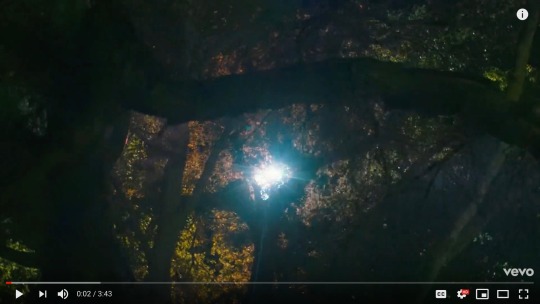

Selena is in a dark place, turning towards the sun’s rays. She is transported to a garden, where she lays asleep on the grass.
Sun pg 22
The nuclear fusion at the core of “our hot, stable, brightly burning star” (Greene, 171) convert 4,000,000 tons of matter into energy every second, a small amount of which supports life on earth. To sun worshippers over millennia, solar rays have seemed to transfer magical properties of fertility, creativity, prophecy, healing and even (for the alchemists) a living potentiality for wholeness that dwells in every individual. No wonder then that the sun has evoked the illustrious, worldy prestige and authority of rulers and royalty who were the sunlike crown, the world-transcending intelligence of the “enlightened one,” the pellucid vision of the haloed saint, and the solificatio or achievement of highest illumination by the initiate of mysteries.
Garden pg 146
Most often gardens are set apart from the pressures of ordinary life for pleasure and contemplation. In many languages the word garden signifies enclosure, bringing to mind walled gardens, secret gardens or mythical gardens - hidden, supernatural worlds transcending time and disorder. The garden paradise is the imagined locus of our beginning and end, the original matrix and mandala of life, fed by underground sources of living waters. The Garden of Eden, the Elysian Fields, the Pure Land or Western Paradise of Buddhism, the Garden of the Hesperides where Zeus and Hera were wedded are all enclosed paradisial garden worlds whose inhabitants are divinely protected. The paradisal garden variously reflects our fantasies of an idealized inner space of potential wholeness and hidden design, or a preconscious state of innocence and harmony. Medieval Christianity projected on the Virgin Mother the soul of the paradisal cosmic garden: inviolate, self-generating and contained.
The gates of entry to secret gardens are typically invisible, narrow, difficult to find. Just as in the processes of individuation one repeatedly circles the more accessible aspects of the personality, only gradually moving closer to the center, so in dream or myth one might have to circumanmulate the outer garden wall many times before the portal to the interior garden is revealed. Physical or imagined, gardens are often arranged to reflect designs of wholeness, a quaternary form, for example, with a fountain, tree or image of a deity in the center.
In almost all cultures and religions, the garden represents a sacred place, a uniting of the conscious self with its unconscious source. Muslims speak of gardens as states of bliss and call Allah “the gardener.” The spare gardens of Japan are commonly not viewable all at once; they gradually reveal themselves in spaces opening along pathways and waterways where one may stroll and contemplate. the Zen dry gardens, stripped to the very essence, convey the eternal through an abstract and mystical design, making gardening a path to enlightenment.
Selena has been transported by the sun to a sacred and safe magical garden so she can heal, grow, and transform into her best self.
Gardens are a feminine symbol (see here).
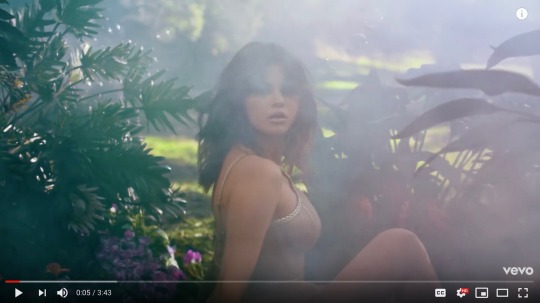
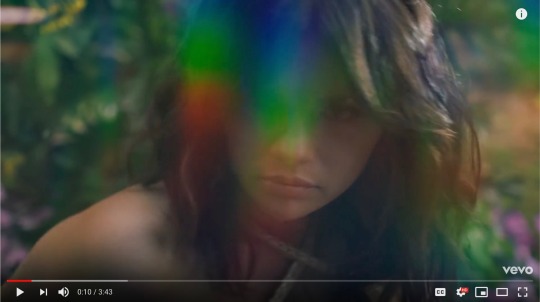
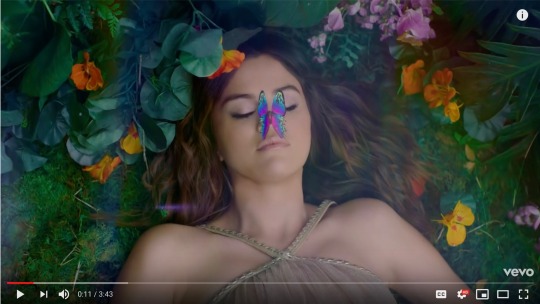
Selena wakes up after a rainbow butterfly moves up from her mouth (previous section) to her nose. The garden is full of bubbles and rainbow light.
Rainbow pg 72
Rainbow is the sign of renewal, the transmuting changes of the heart and the eros of covenant between heaven and earth. [cut] For many, however, the rainbow represents the imaginal bridge that links the visible world and all that is invisible, magical and supernatural. Fantasy peoples the rainbow’s unseen perimeters with angels, fairies and elves that guard abounding treasure, the bright gold and luminous pearls of wisdom, creativity and mercurial play. Myth has portrayed the rainbow as the highway over which psyche’s supernal emissaries bring their messages to consciousness. From the rainbow bridge the Japanese divine couple Izangi and Izanami stir the primal sea of potential with a jeweled spoon whose droplets coalesce into living matter. The spirits of the Hopi kachinas, or ancestors, descend from the celestial realm of the dead to the land of the living by means of the rainbow, whose earthly counterpart is the ladder descending into the kiva.
Butterfly pg 234
From ancient times the butterfly, psyche, has signified not only the mystery of physical metamorphoses, but also the lovelies transmutations of the soul. [cut] All over the world the gossamer beauty of the butterfly, its winged nature and breathtaking release from a pupal cocoon have symbolized the soul reborn out of chrysalislike containment. [cut] Like an alchemical vas, the chrysalis is both the “golden” (chryseos) vessel of transformation and the object transformed; swaying gently in the wind, it gives no outward sign of the concealed unfolding within as the old forms dissolve and the embryonic tissue is restructured. The butterfly is one of our most poetic images of psyche’s self-renewal beyond even traumatic endings.
Nose pg 362
The nose’s long biological development means that it connects our consciousness to the most ancient and intensely emotional parts of our brains, allowing an entire world to be recovered by the trailing scent of a Christmas spice - or in Proust’s case, by a madeleine dipped in lime-blossom tea - retrieving the soul of one’s past as can no other sense. The Egyptians understood that the breath passing through a goddess’ nostril to give eternal life to a deceased king would impart a fundamental reality, for the nose is like a forgotten portal to the archaeology of the psyche.
Bubble pg 52
In contrast, the archetypal symbol of a bubble exists in the psyche beyond time and space. It constitutes an invisible reality imaged by mystics throughout the ages, a round nothingness that is paradoxically the primordial source of all. The unseen forces within the archetypal bubble symbolize the oneness, [cut]. Throughout history, the translucent bubble has inspired contemplation of the infinite and the eternal. In ancient Egypt the Ba soul, or ghost that appeared after death, flew in and out of the tomb as a weightless bubble. Like the circle or sphere, the globular roundness of the bubble connotes oneness, wholeness, totality, completion and spiritual perfection. The translucency of the bubble introduces, in addition, the numinosity, ethereality and spirituality associated with the celestial light of heaven.
A rainbow is the most common queer symbol in modern times.
The rainbow butterfly symbolizes Selena’s inner soul, which is inherently queer and about to be transformed. She awakens only after the butterfly moves from her mouth to her nose; symbolizing that her soul is awakening so her whole self can be transformed.
The bubble symbolism continues to show us that the garden is a sacred, safe, and magical place of transformation.

A vibrant rainbow moves throughout the garden. We see the magical lifeblood running through Mother Earth’s veins. The garden is a safe space alive with spirit and transformation, just like a womb.
Womb pg 400
In traditional Native American rites and creation myths, Earth is the primary womb. [cut] Living beings - plants, animals, humans - emerge from their gestation deep within her womb, and return to it in death, to be born again. Thus the highest and most essential mysteries of the feminine are symbolized by the earth and its transformations (ibid, 47), and those reborn in rites of initiation describe themselves emerging as “fresh-baked pots” (ibid, 137).
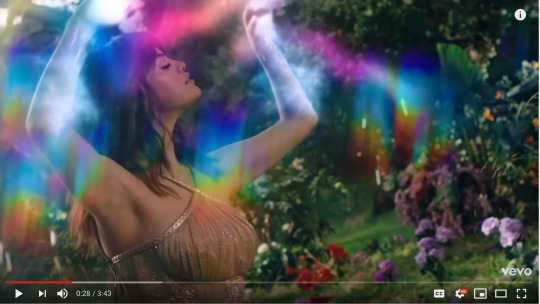
Selena stands in the middle of the rainbow. When her arms mimic the motions of wings, the white light of spirit/ether gathers on her arms.
Wings pg 240
In our desire for boundless freedom, we identify ourselves with the flight of birds. In our imagination we transcend the ordinary world by leaving the earth and the weight of the body. Wings lift us. “Hope is a thing with feathers,” says Emily Dickinson. Plato declared, “The function of the wing is to take what is heavy and raise it up into the region above where the gods dwell.” According to Black Elk, “The most important of all the creatures are the wingeds, for they are nearest to the heavens.” With wings we can look at things from both the perspective of earth and heaven at the same time. Intuition and inspiration seem to arrive unexpectedly on wings out of thin air as the first sign of any creative act. All kinds of winged beings connect us with the world beyond: the white dove of the Holy Spirit and Aphrodite, the black crow and raven, the angel, equally half-bird half-human, daimon and duende, as the voices of destiny, Mercury, the winged spirit of alchemy, the ancient shamans who flew to other worlds on their magical wings and imagination itself is winged. They return, each with their unique message.
Selena’s queer soul is starting to transform and transcend her old self.
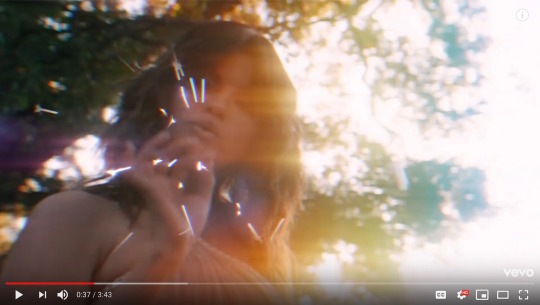
Selena’s fingers are creating sparks.
Spark pg 86
The origins of the word spark attest to its fertile, spermatic quality as well as its animating, vital essence. The Greek spargan means to swell, teem, abound and then break or burst forth, also relating to a sprout or germinating plant life. In Latin, spargere is to strew or scatter, as seeds of activating light might be sown in the darkness of fixity or stagnation (Partridge, 645). [cut]
Sixth century Greek philosophers talked of the soul being made out of star-stuff. The Gnostics saw the soul of a human as a spark or seed of light from the greater fire of God, [cut].
Selena is beginning to harness the power of her soul.

While there is a range of flower colors, a significant majority are purple. Purple is the bisexual color because it is the combination of red/pink and blue.





A lot more rainbow lighting as Selena’s soul continues to heal and transform.

Selena is in an outdoor pool with butterflies in her hair (I’ll go over the pool symbolism in a little bit). The butterflies symbolize her soul’s transformational process.

More transformation.

In a dramatic switch, Selena is now in a plastic room. Plastic is a synthetic material. The room symbolizes a fake (not authentic) and confined space. This is the polar opposite of the sacred garden.

Back to the garden, where Selena becomes one with a rainbow. This symbolizes that her authentic self is queer.

Selena has her head tilted towards the sun. There are bubbles in the air and dew on the spider’s web.
Dew pg 74
Science has explained dew as water droplets condensed from the air at night onto cool surfaces. This mystery of the darkness that leaves all the plant life glistening at first light has contributed to dew’s symbolic potency. For the ancients, the refreshment and cooling balm of the dew was evidence of divine visitation and divine gift - of Eos, or the rainbow messenger Iris, or the starry, overarching Egyptian Nut in her night-sky aspect. Because of its “heavenly” source, others saw in the dew tonic and panacea, even a mystical mirror in which the world was reflected. Buddhist literature speaks of Kuan Yin emerging from the center of the lotus with her vase of the “sweet dew” of compassion (Matthews, 94). Ethereal, evanescent, vanishing with the appearance of the sun, dew was the imaginal food of spirits, or the form that souls took following the cremation of the body (ERE 4:698).
Dew’s relation to both night and dawn has also made it a portent of transpersonal intervention and illumination. In the biblical Exodus, dew heralds the “manna,” the bread that God sends to feed the Israelites in the wilderness: “and in the morning dew lay round about the camp. And when the dew had gone up, there was on the face of the wilderness a fine, flake-like thing, white as hoarfrost” (16:13-4). For the early Christians, dew symbolized the gift of the Holy Spirit, a boon from heaven that revitalized parched souls. Borrowing in part from these sources, alchemy found in the dew a synonym for the aqua sapientia, the mercurial water of wisdom (Abraham, 53). Not merely an intellectual form of understanding, but incorporating feeling values, the “dew” alluded to psyche’s capacity to freshen and reanimate the personality desiccated by unconsciousness of its soul-stuff. The illumination of these contents, like glistening drops of dew, represents the “moisture that heralds the return of the soul” (CW 16:483ff).
Spider pg 220
Like a latticed window whose center looks on eternity, the spider’s web intimates the instinctual patterns of behavior out of which psyche’s dark and luminous agency is felt, mythically identifying the spider with divine creator, culture-hero, trickster and benefactor. In a Hopi creation story, Grandmother Spider lives in an underground kiva that mimics the trap-door spider’s dwelling and recall the Hopi’s emergence from the “underworld.” A Navajo tale describes Spider-Woman lodging behind the hero’s ear, whispering secret advice and mediating his transit between physical and subtle dimentions, all within life’s encompassing web. The spider Anasi of West African tradition is an unscrupulous buffoon but also a trickster that outwits larger creatures such as the elephant or lion (Courlander, 135). The spider’s ever-renewed, wheel-like web has been compared to the radiating sun. In Hindu Myth the veiled Maya is spinning the world of illusion out of her substance and drawing it back in.
Selena is embracing the healing and transcendant light of the sun. The dew and bubbles symbolize that her soul has transcended it’s old self and is now moving towards rebirth (the spider’s web symbolizes the dark womb where her soul safely transformed).

Selena has fully embraced her queer self and is now the embodiment of bisexuality.

Selena walks towards a statue of herself.

Selena is back in front of the spider’s web, we have gone back to her transformation process.
There is glitter on her palm. Glitter sparkles and shimmers, it’s a type of spark (see above). Selena’s soul is transforming and she is harnessing her ability to authentically shine.

She has taken the dew, her soul material, into her own hands.
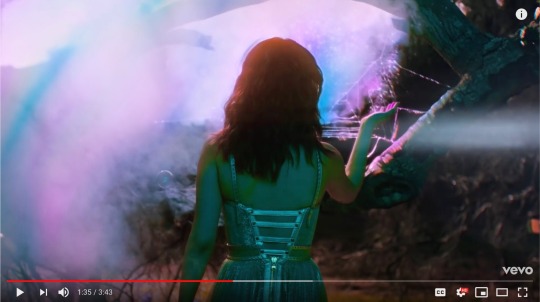
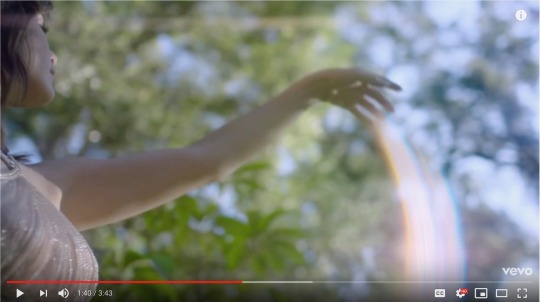
The video continues to cycle through day and night, showing Selena’s transformation process. Here she is making a rainbow of ether with her hand.
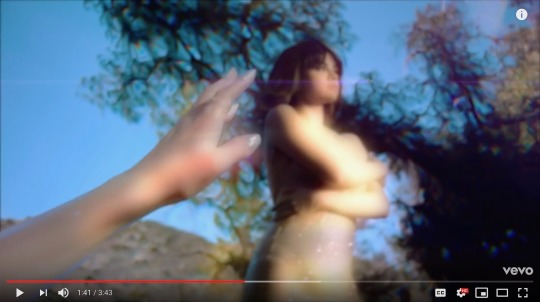
Selena is reaching towards the statue of herself.
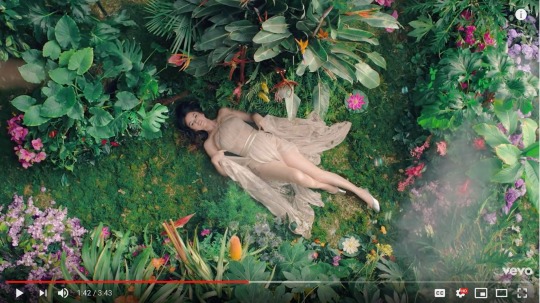
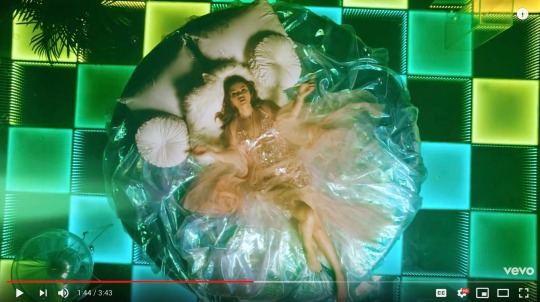
The scene switches from Selena taking a healing rest in the sacred garden to being stuck in synthetic confinement.
Bed/Bedroom pg 598
Distanced from the pressure and activities of daily life, the bedroom can be a timeless place, a haven of stillness. Here, one might be closest to one’s private self, shed one’s clothes, go to sleep and dream, perhaps make love or simply rest and recuperate from the pressures of the outside world.
But the bedroom can also be associated with exposure, nightmare, fear of the dark and supernatural visitation. One can be confined to the bedroom, even imprisoned there. In the bedroom are enacted incest, misalliance and conjugal war. Gnawing anxieties can fill the space emptied of the day’s welcome distractions. The bedroom houses sickbed and deathbed.

Selena is surrounded by bubbles, steam, and bi colored lighting while she is in the pool. The pool is another sign of transformation and renewal.
Pool pg 606
Thus, the pool in the Egyptian image is both domesticated nature and a small reservoir of the infinite brought into the midst of ordinary life. The product of human culture, the pool’s rectangular sides are a temporary collect for the ever-moving energies of both water and the spirit. There are many images in religion, psychology and myth that evoke a simple pool that contains the waters of continual renewal. These are the “still waters” of the 23rd Psalm, where amid green pastures God “restores my soul.” Isaiah enjoined “everyone the thirsts, come to the waters” for the soul’s refreshment (Isaiah 55:1). The baptismal font is a kind of miniature pool holding holy water for the sanctification of a child. Similarly, pools are used for the full immersion baptism practiced by some Christian denominations. The pool at Bathesda (John 5), when troubled by an angel, became a healing bath for the first person who immersed himself in it. At that site Jesus performed a miracle, making an infirm man whole.
The aphorism “Still waters run deep” hints at meanings far beneath the pool’s placid surface. In the symbolism of psychology, a pool of water represents the wellspring from which all psychic life flows (Whitmont, 72). These waters can be a perpetually replenished source of revivification or, left neglected, they can become a stagnant pool.

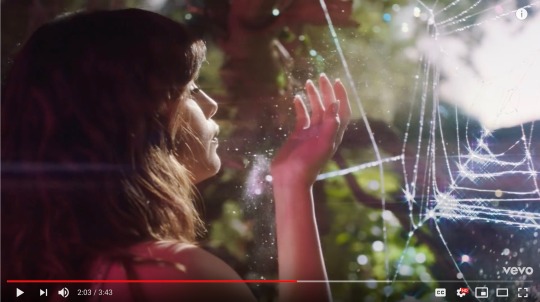
The video continues to cycle through Selena’s various transformational scenes. Then she blows the glitter (her soul’s shine) onto the sipider web; the dark womb of transformation.

Selena is back in the field of predominantly purple (bi) flowers.



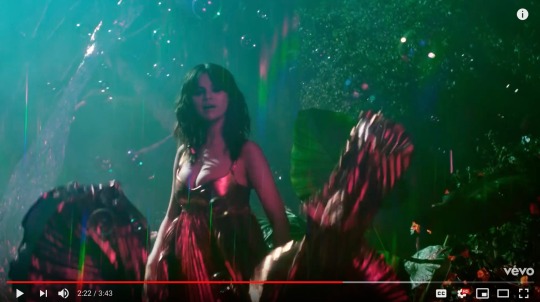
Selena continues to cycle through all the different parts of transformation process.
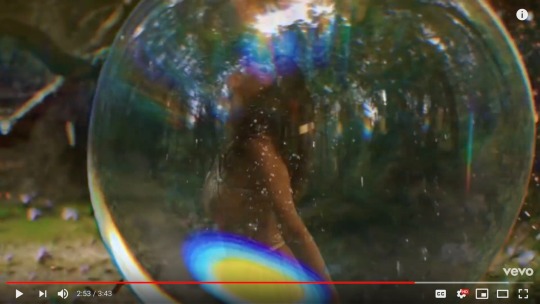

Selena starts out encased in a bubble, which then bursts open. She is emerging from sacred transformation as her authentic and whole self (see bubble symbolism above).

Selena lets the rain, bubbles, and rainbow light wash over her and nourish her soul.
Rain pg 62
The water upon which all of life depends descends to earth as raindrops both gentle and torrential. Rain precipitates growth, change, refreshment, purification and ... disaster. The image of rain in the mythologies of many peoples represents the penetration of the earth below descending celestial, fertilizing powers and points to the sacred marriage of heaven and earth.
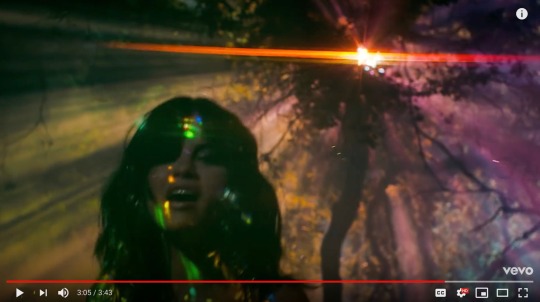
The sun that transported Selena to the garden shines bright here.

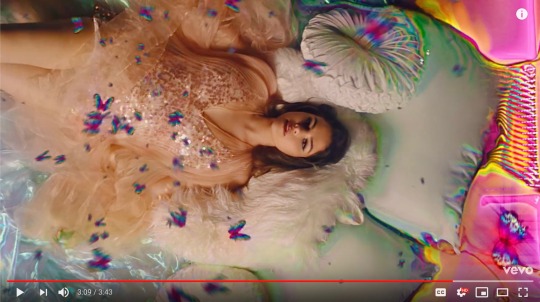

Back in Selena’s synthetic confinement, a multitude of rainbow butterflies emerge from her heart.
At the beginning of the video a rainbow butterfly symbolized the awakening of her soul. Now, her inherently queer soul releases itself into space it’s trapped in. She has transformed and is trying to get out so she can finally fly.
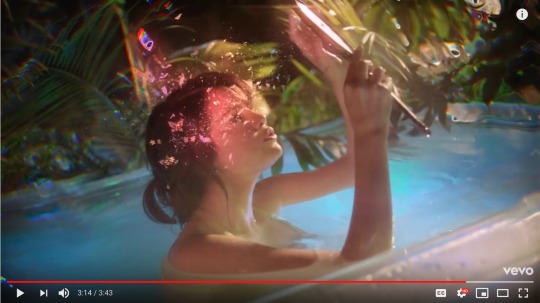
Rainbow butterflies emerge from the mirror to cover Selena.
Mirror pg 590
Mirrors have always existed. Before the use of metal, they were the reflections on the waters collected in the earth’s indentations. Early peoples believed that in such reflections the soul element could be perceived and even today the fantasy persists that the mirror can steal one’s soul. The association of the mirror with the essential nature of a thing is carried in the ancient Egyptian hieroglyph for life, the ankh, which was also one of the words for mirror. The mirror represented the solar disk as the source of light that contained life’s essence. Mirrors were placed in burial chambers and were also cult objects in the worship of Hathor, goddess of abundance, joy, music, dance, cosmetics and self-beautification, which brought one into harmony with the divine (ARAS, 2Ak.191). Our English word “mirror” comes from the Latin mirari, to wonder or marvel at.
Carl Jung said: True, whoever looks into the mirror of the water will see first of all his own face. Whoever goes to himself risks a confrontation with himself. The mirror does not flatter, it faithfully shows whatever looks into it; namely, the face we never show to the world because we cover it with the persona, the mask of the actor. But the mirror lies behind the mask and shows the true face. (Archetypes of the Collective Unconscious)
The mirror contains and shows Selena’s true self, her queer soul, which is symbolized by the rainbow butterflies.
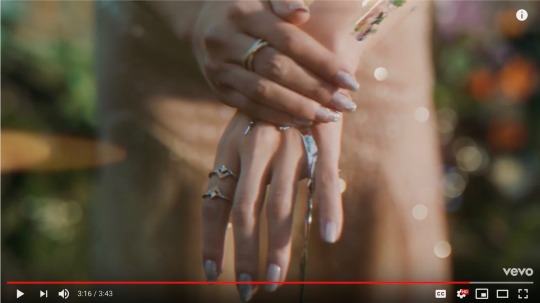
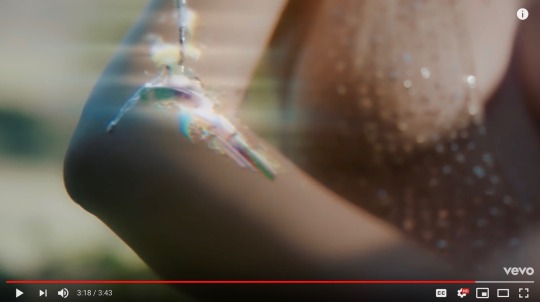


The last time we saw the statue of Selena, she was towards towards it. Now that she is completely transformed, she uses the dew (her soul material) to disintegrate her old exterior and illuminate her soul.

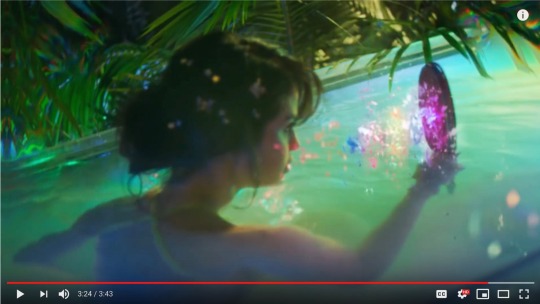
Another beautiful view of the rainbow butterflies emerging from the mirror.



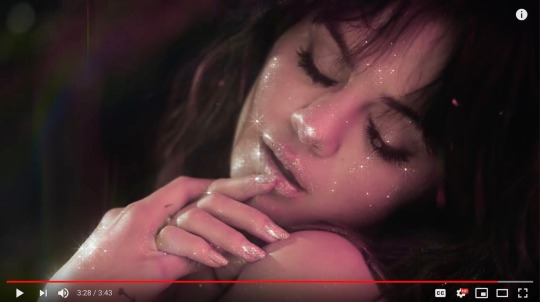
Selena goes from blowing glitter on the womb of transformation to embodying her soul’s spark.

More rainbow light.
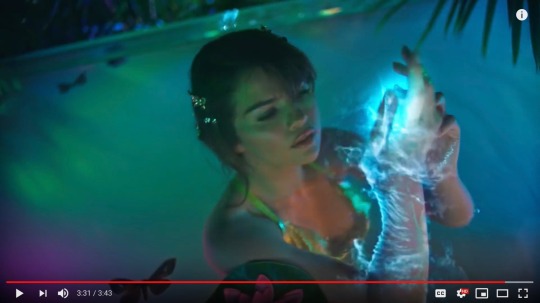

Selena has harnessed the power of her soul, which now shines out of the palm of her hand.
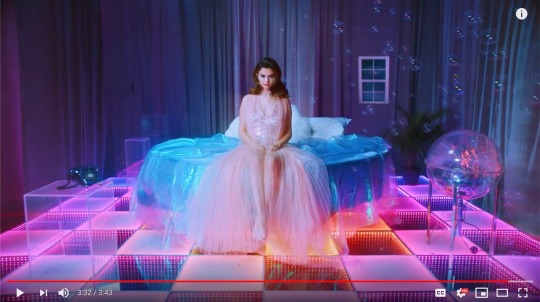

Selena has fully transformed and breaks free of her synthetic confinement, emerging into the natural world of Mother Earth.

Her soul shines through her.

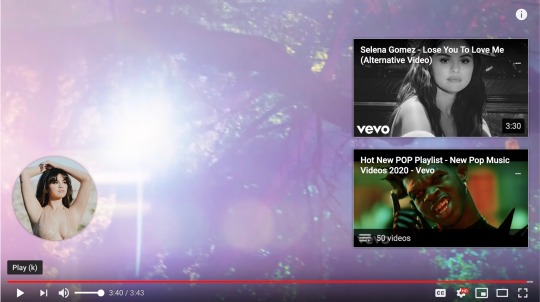
So she turns away from the sun, and is transported to our ‘real world’ Mother Earth.
0 notes